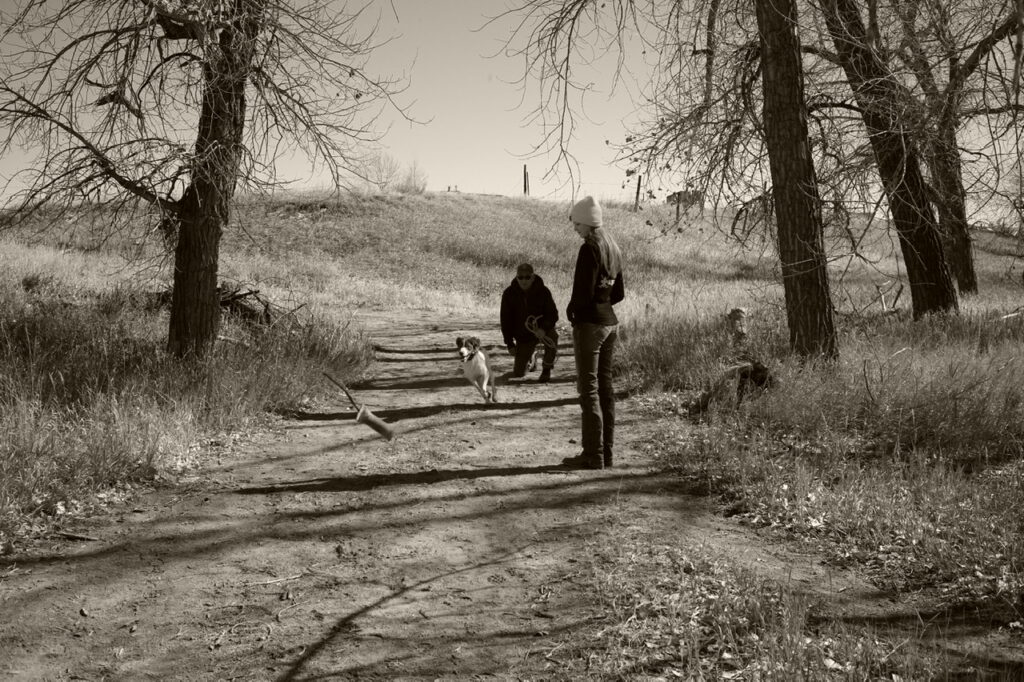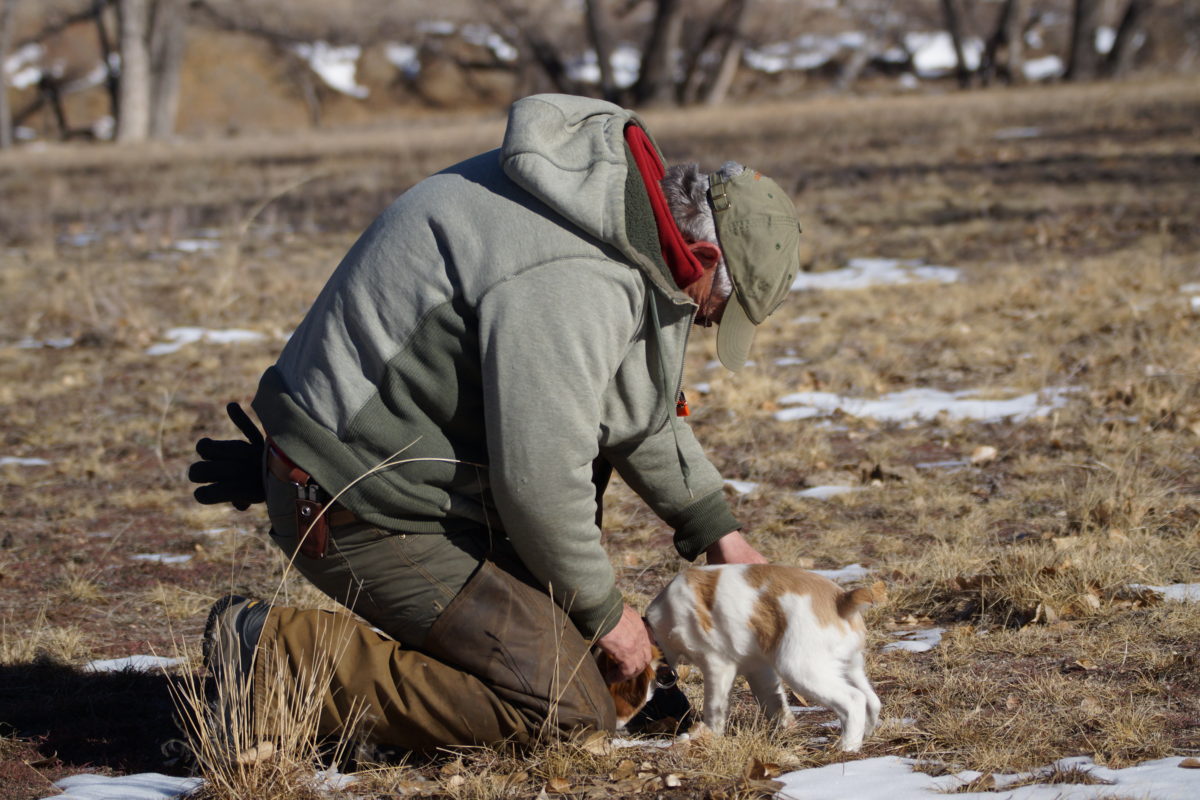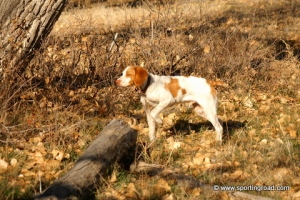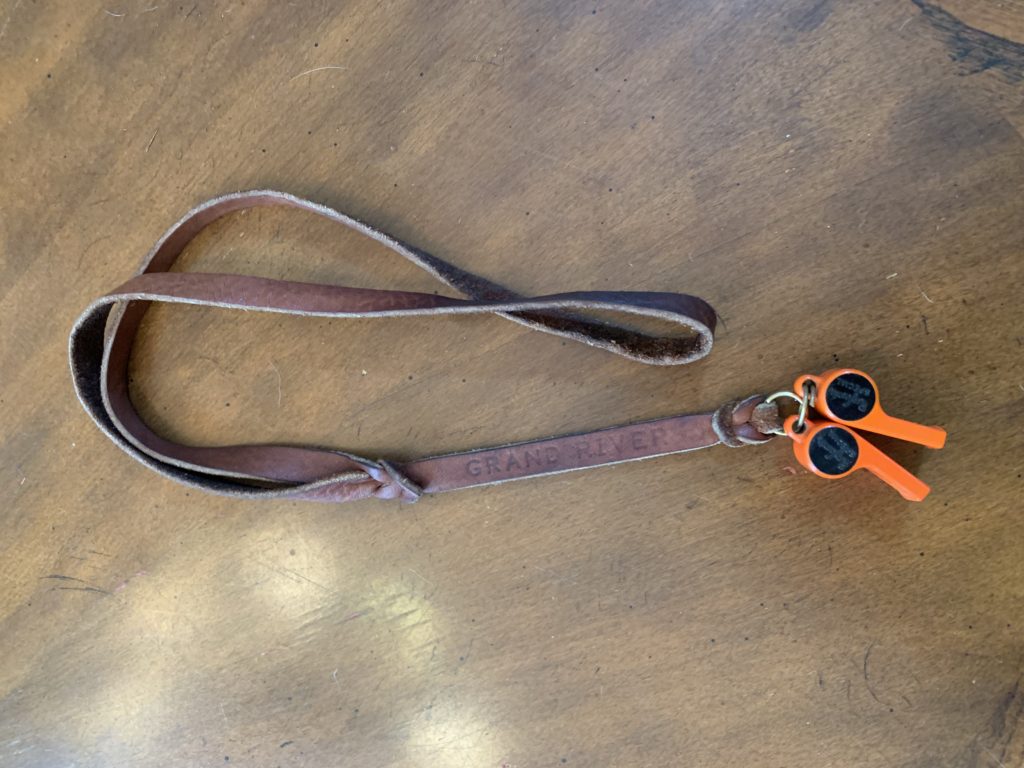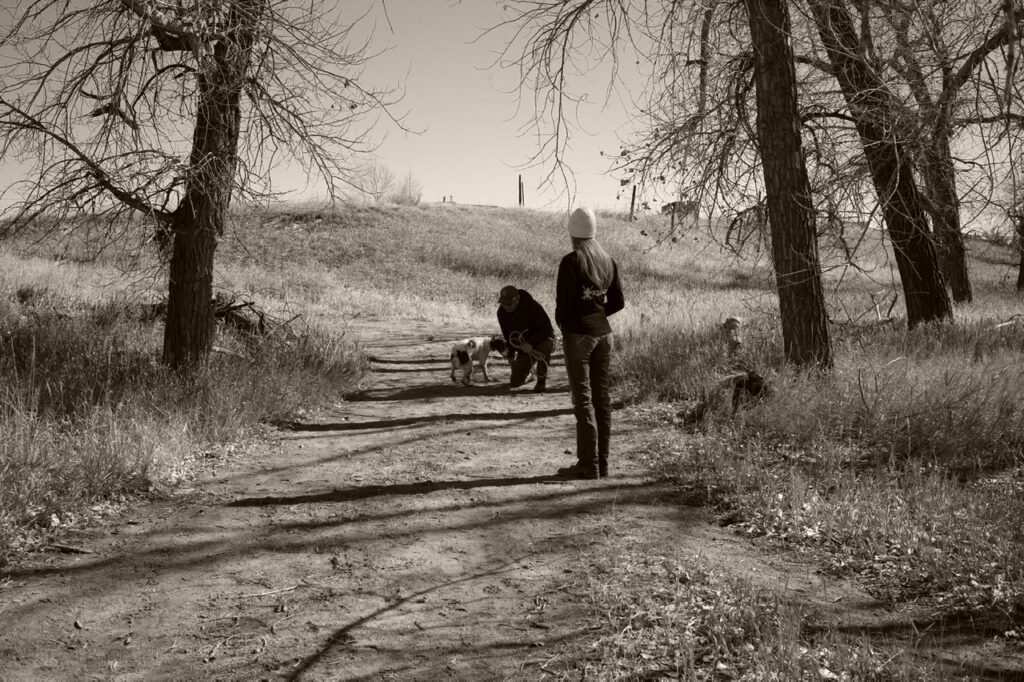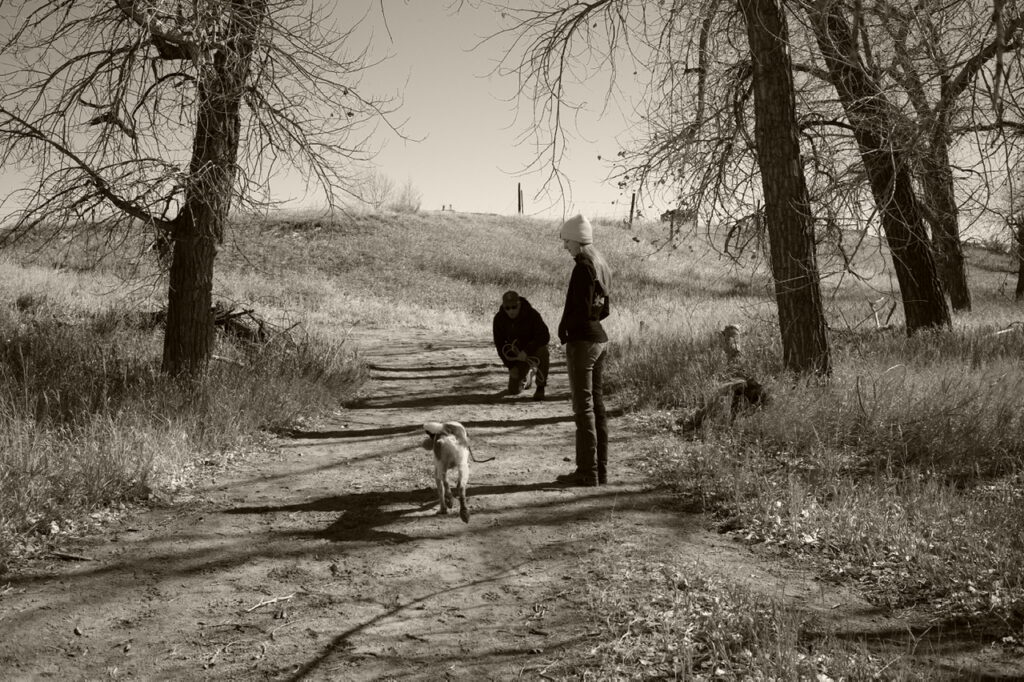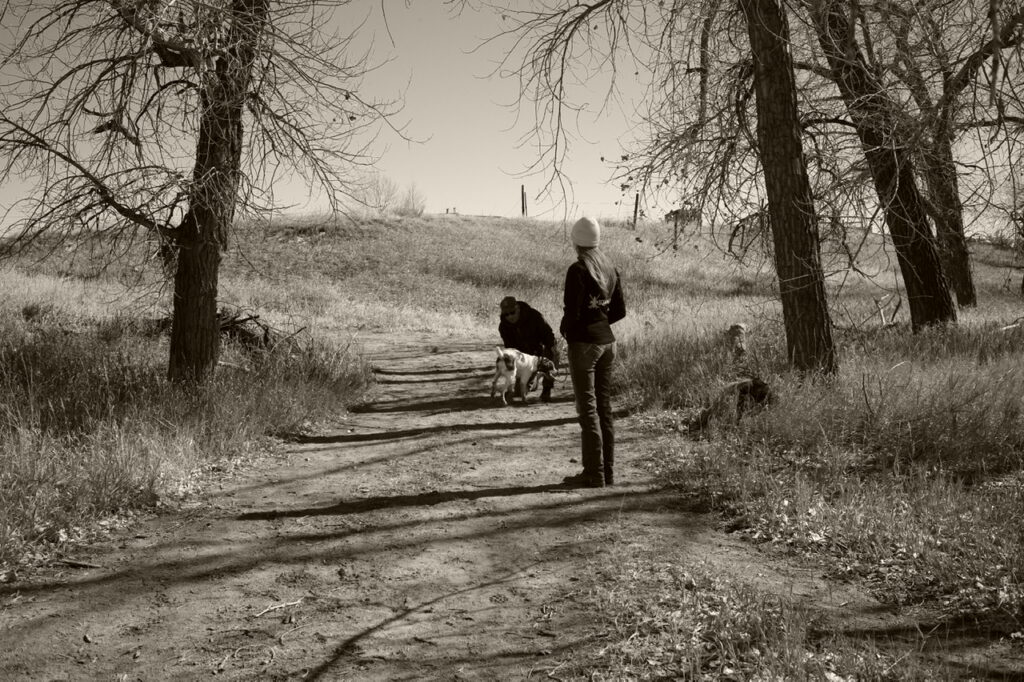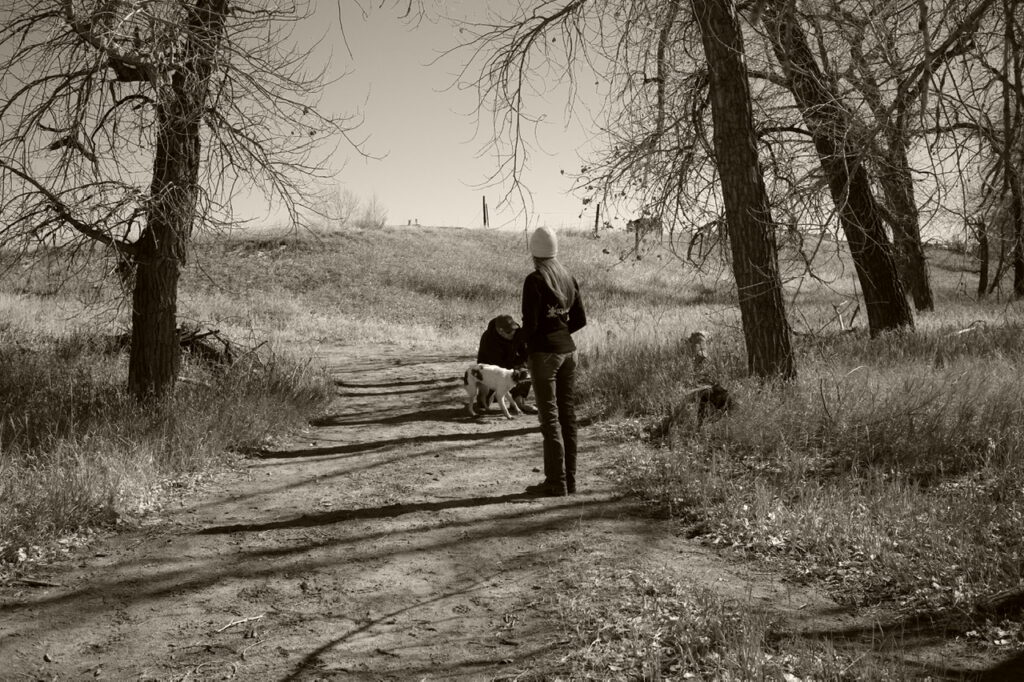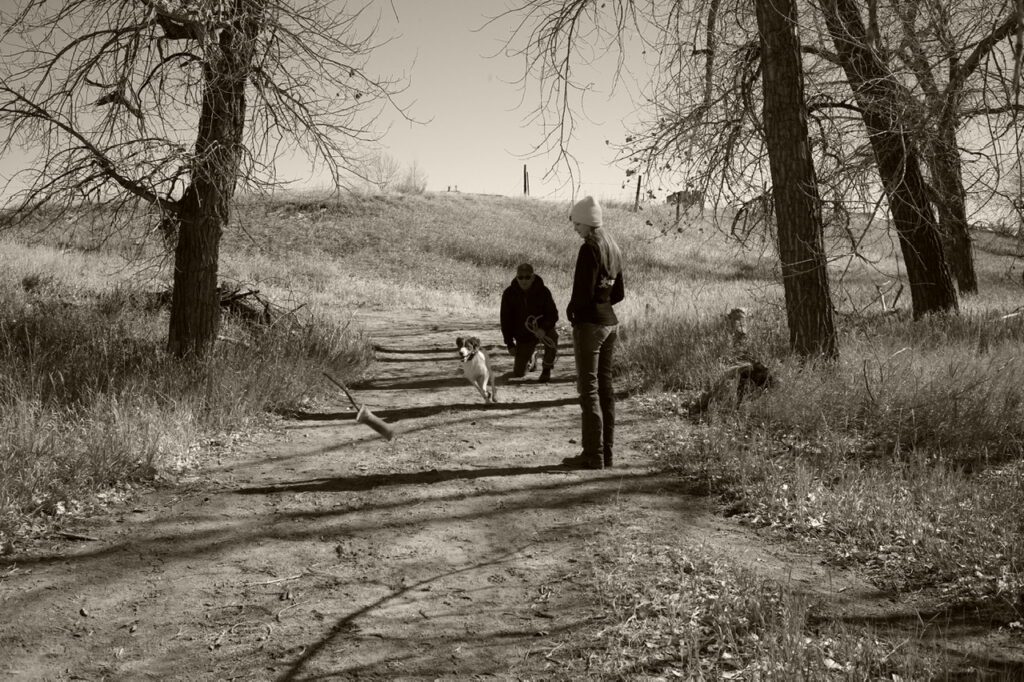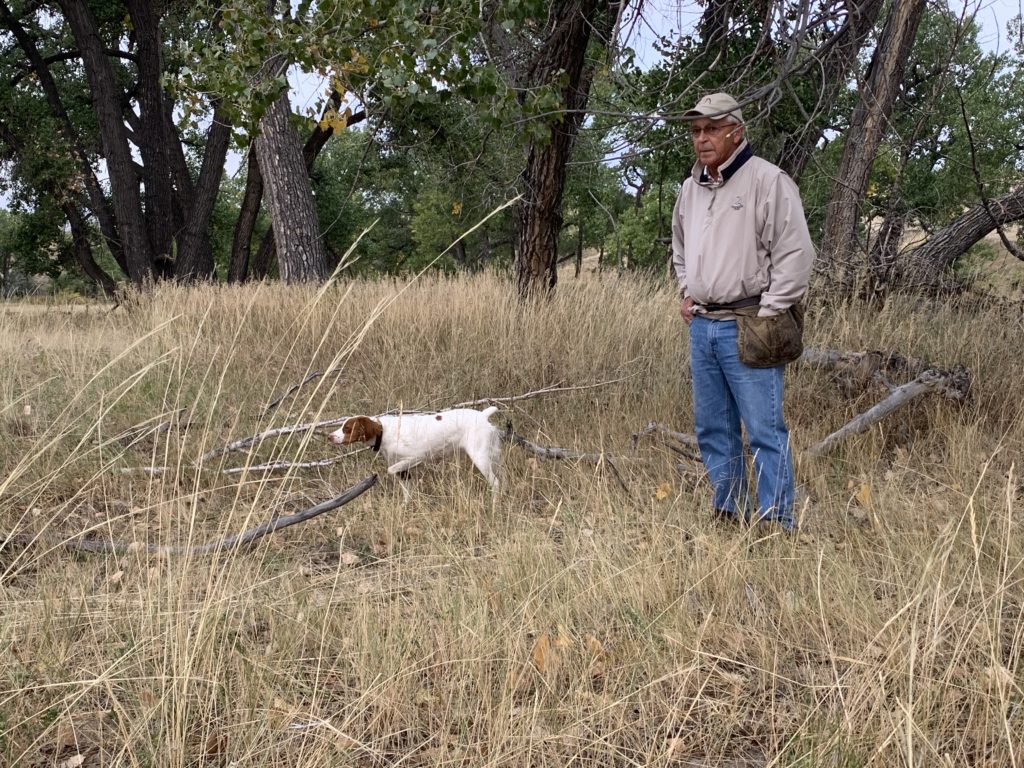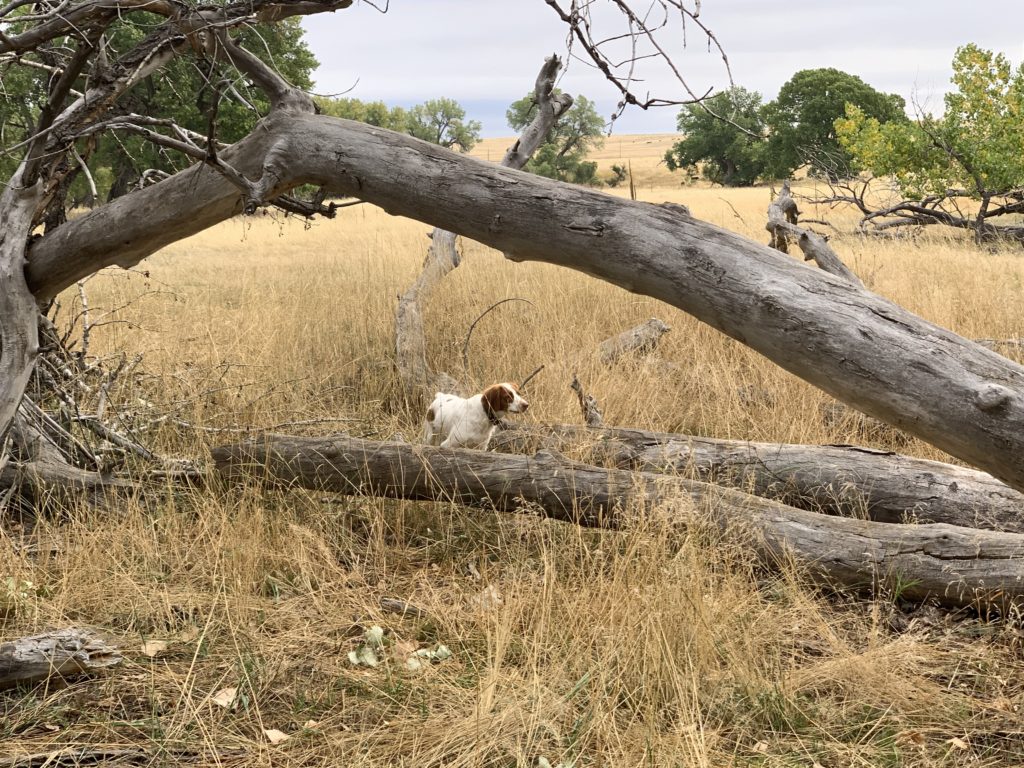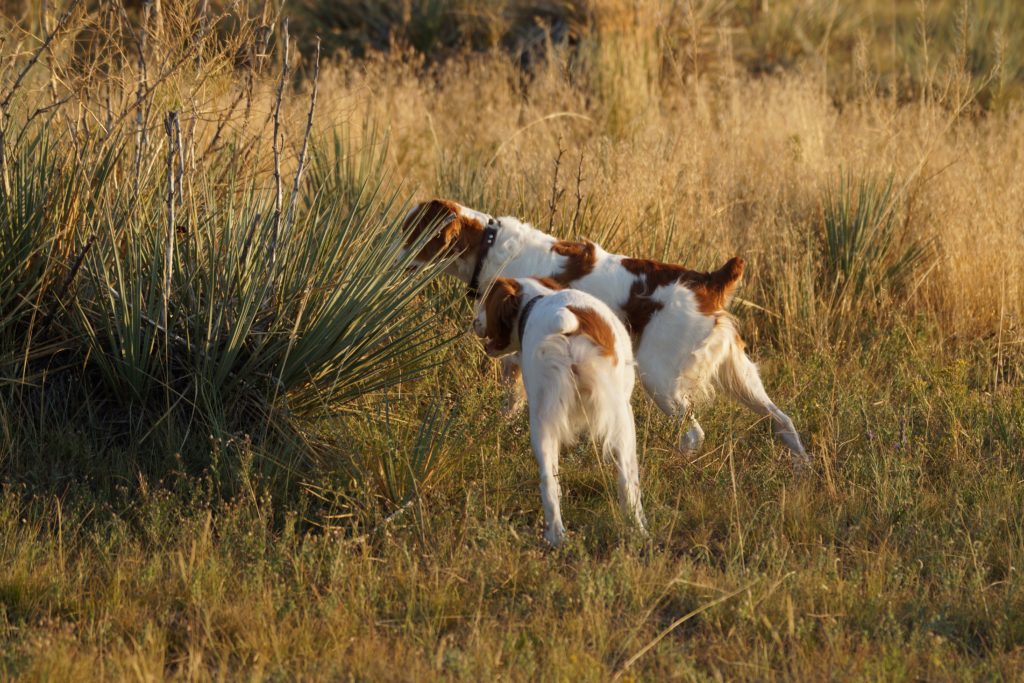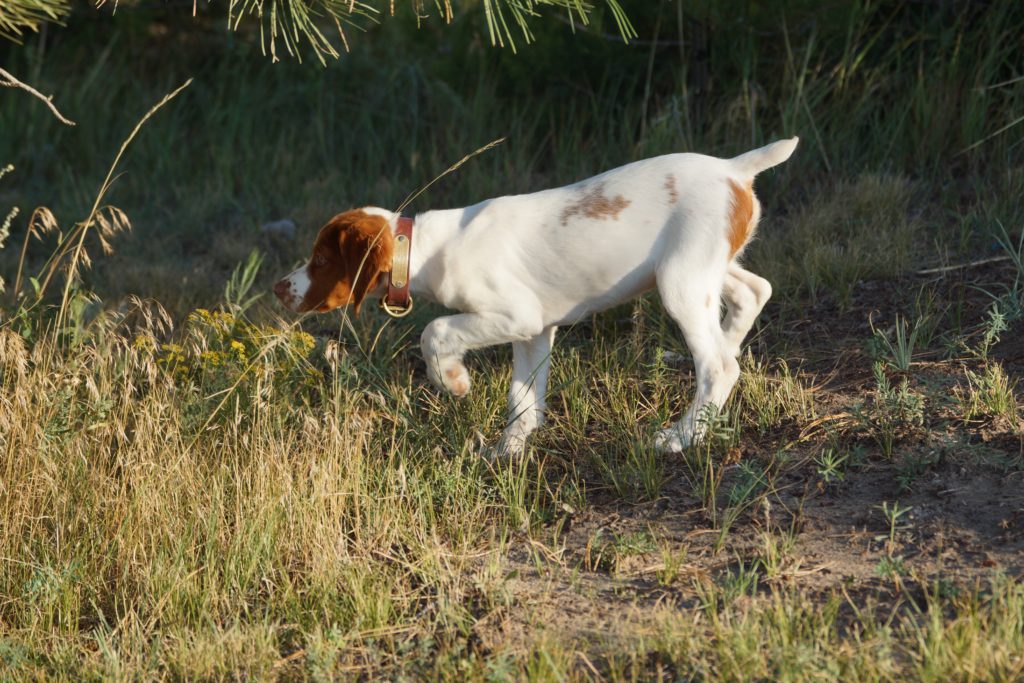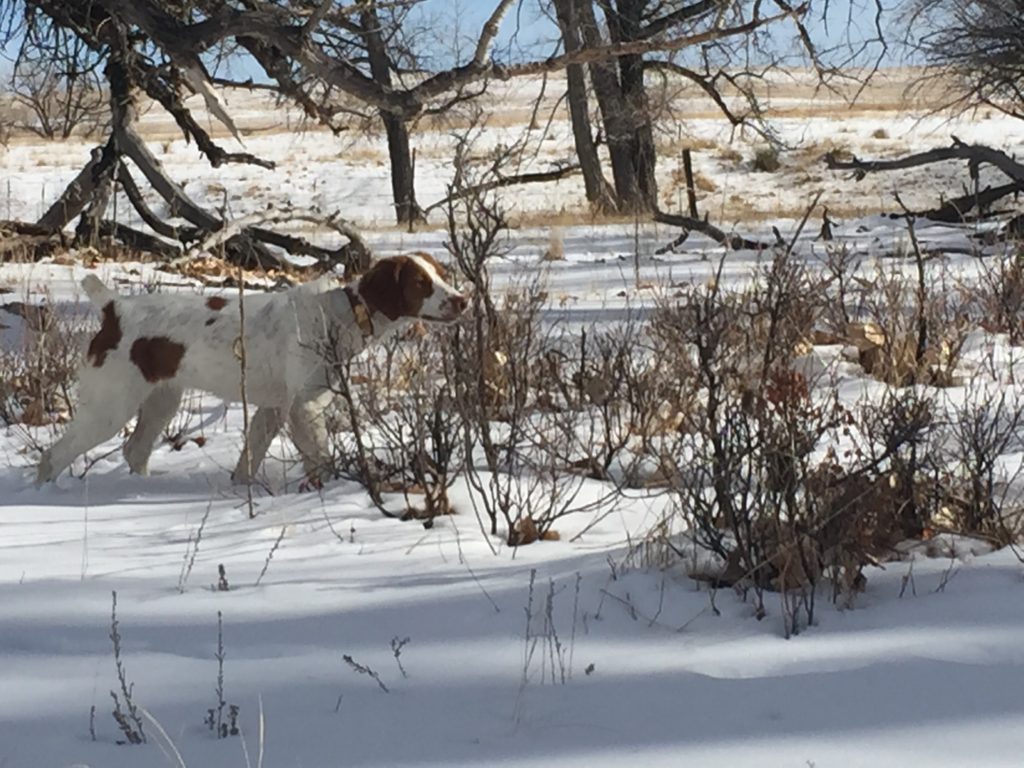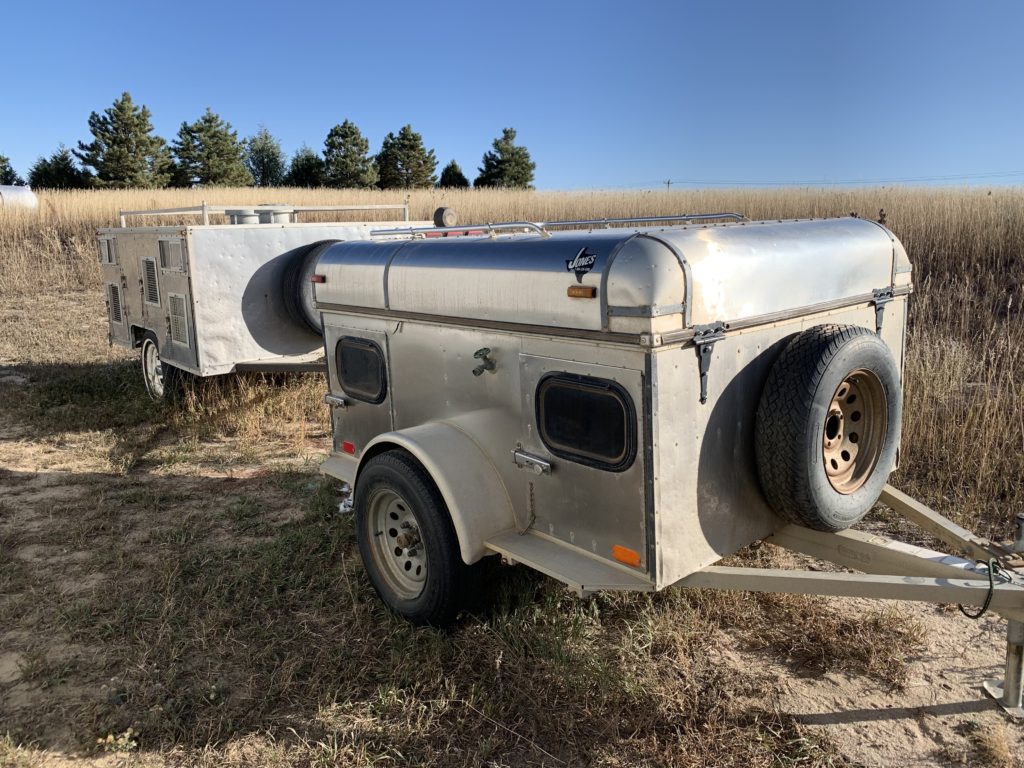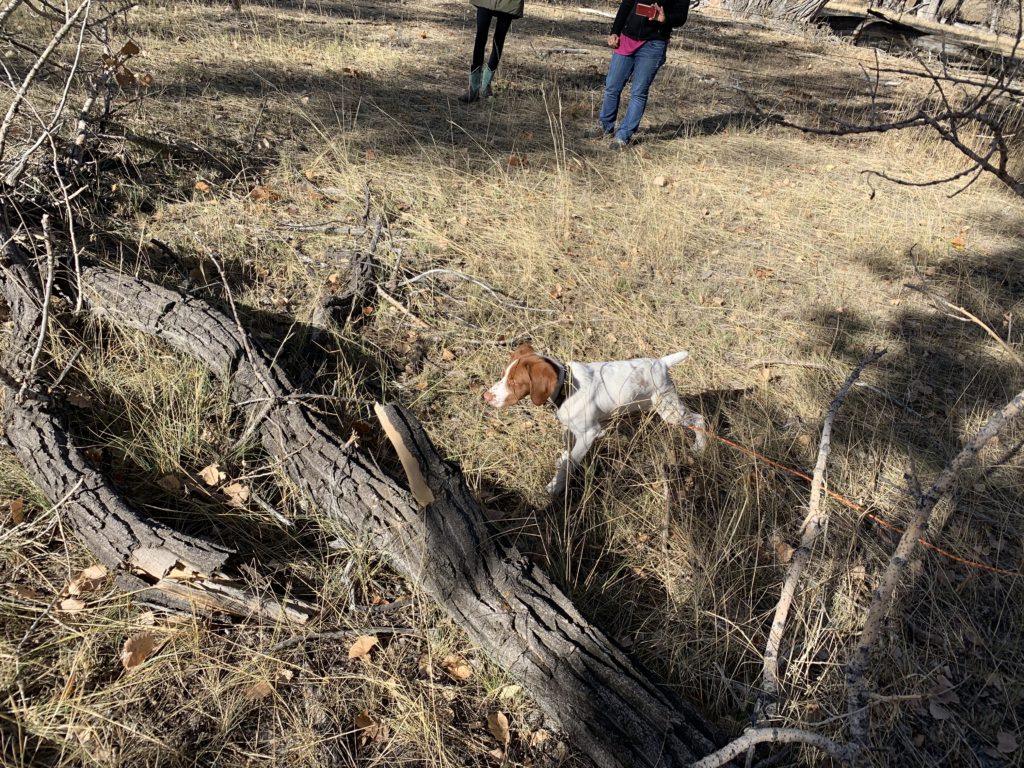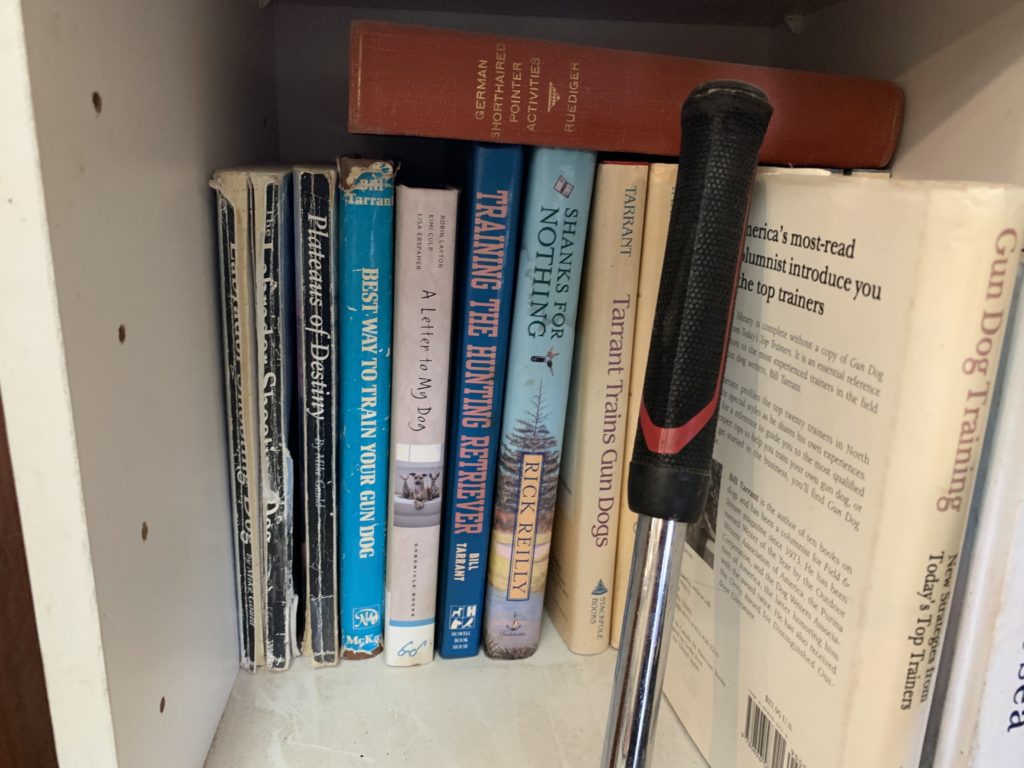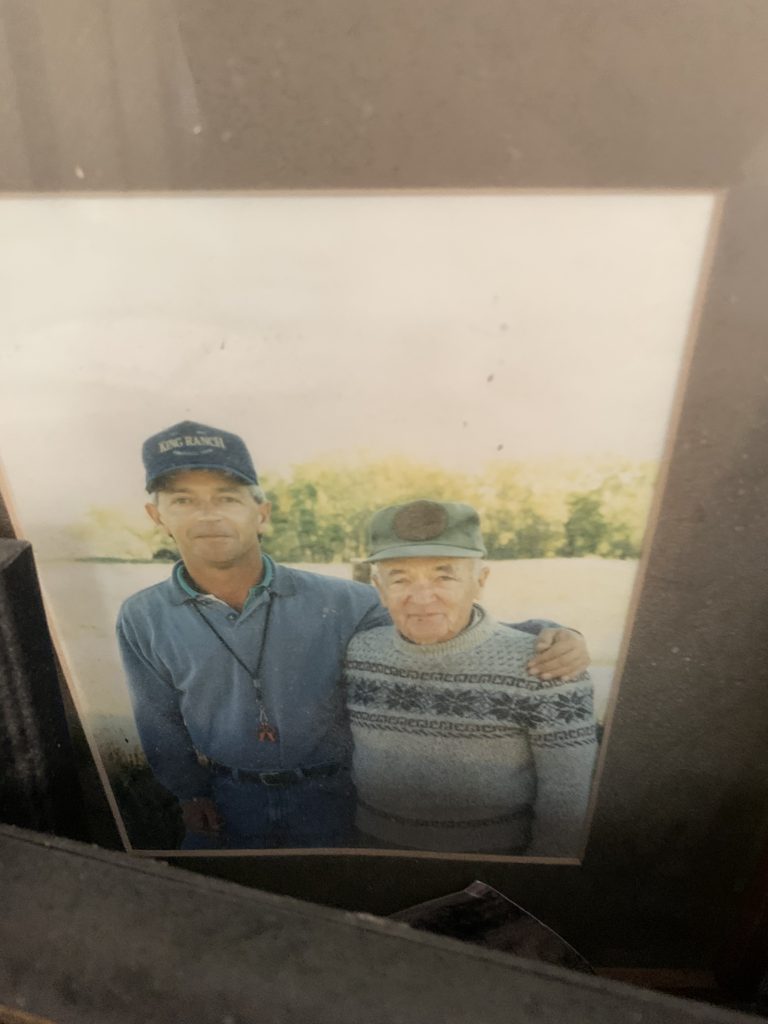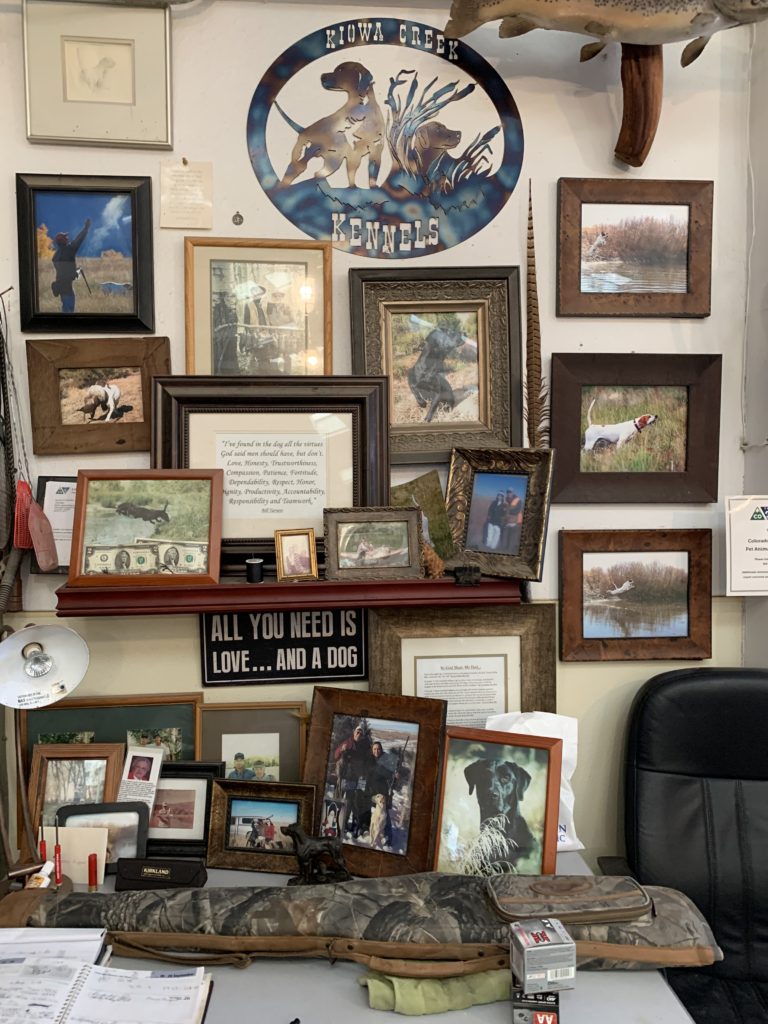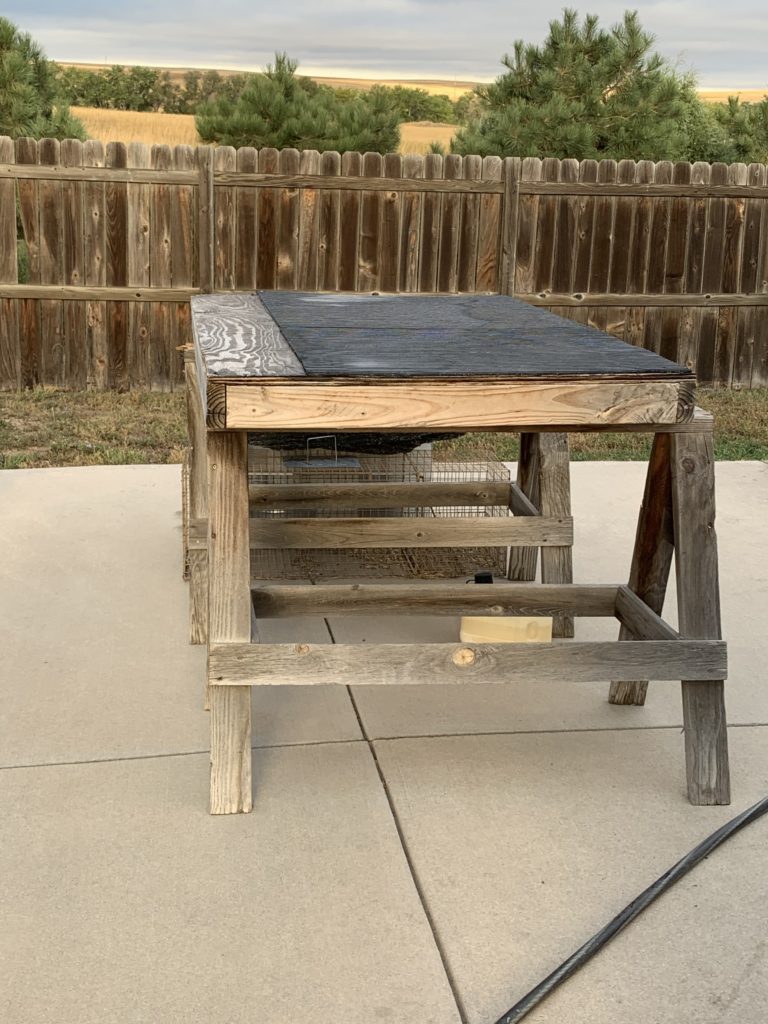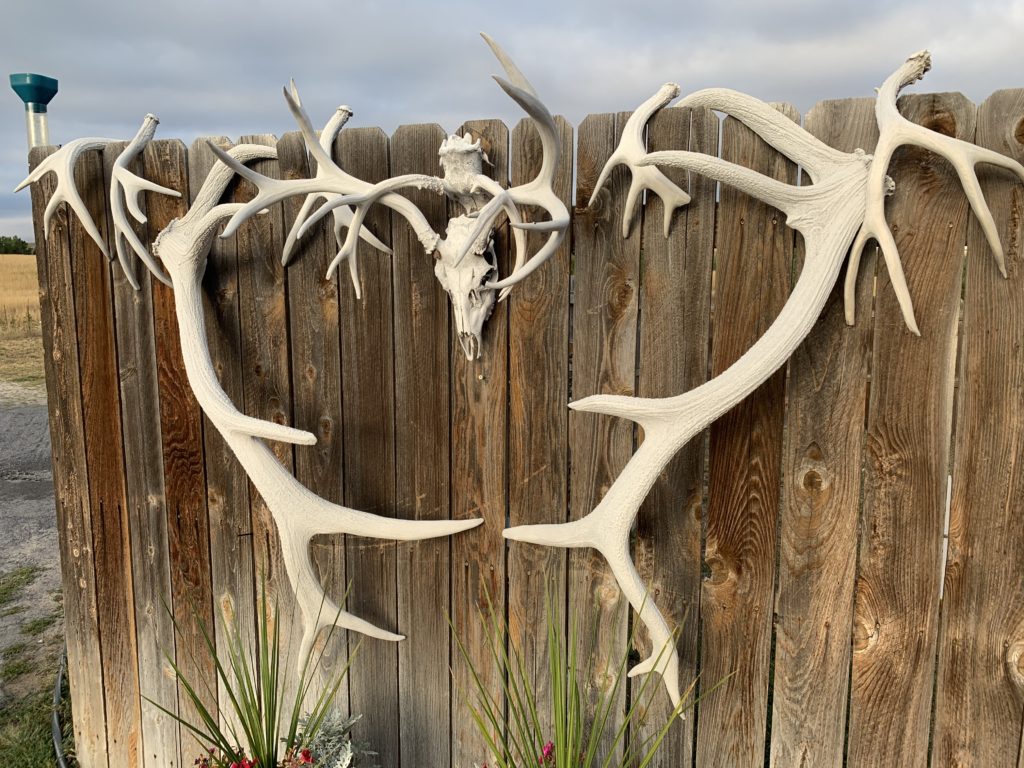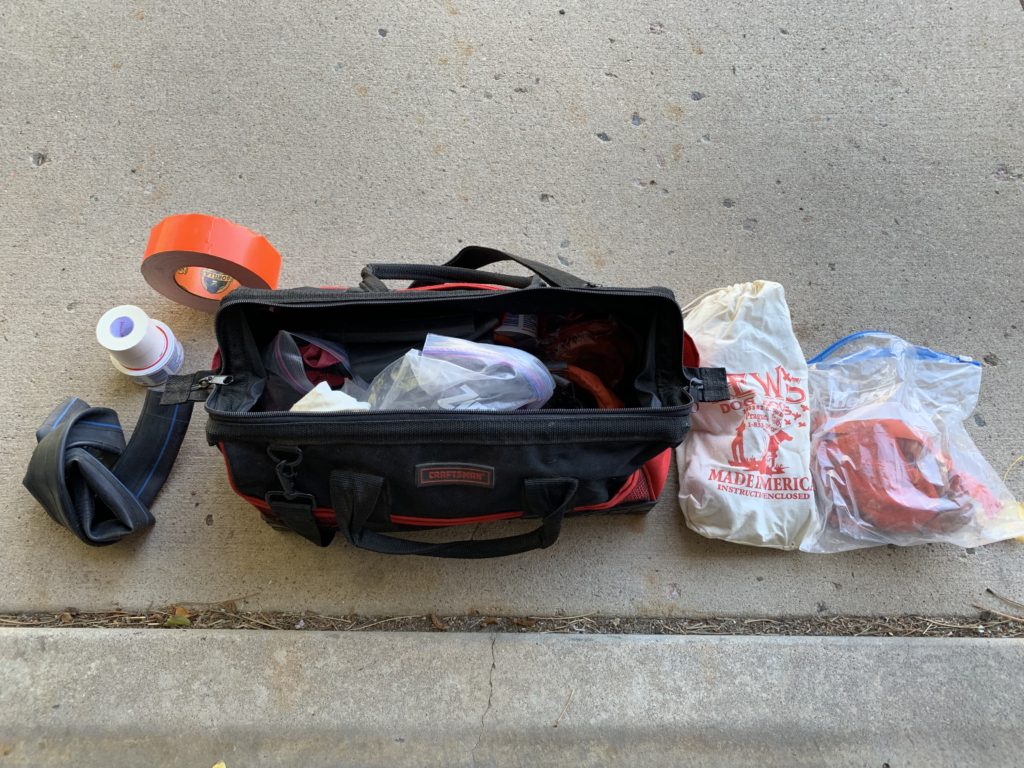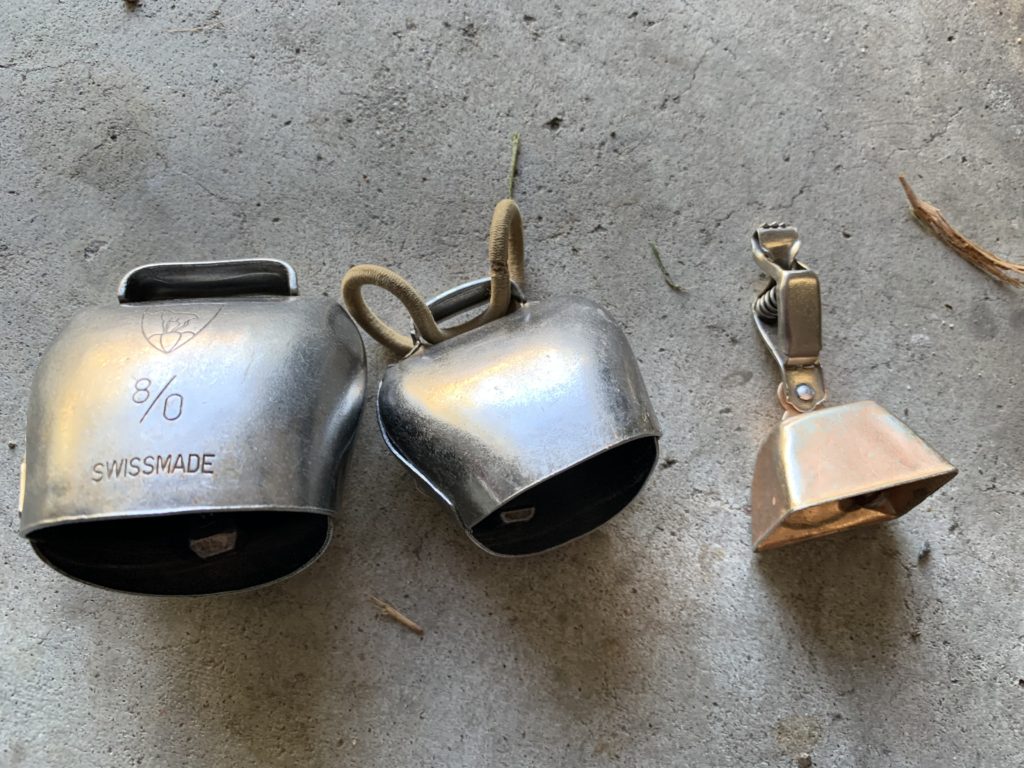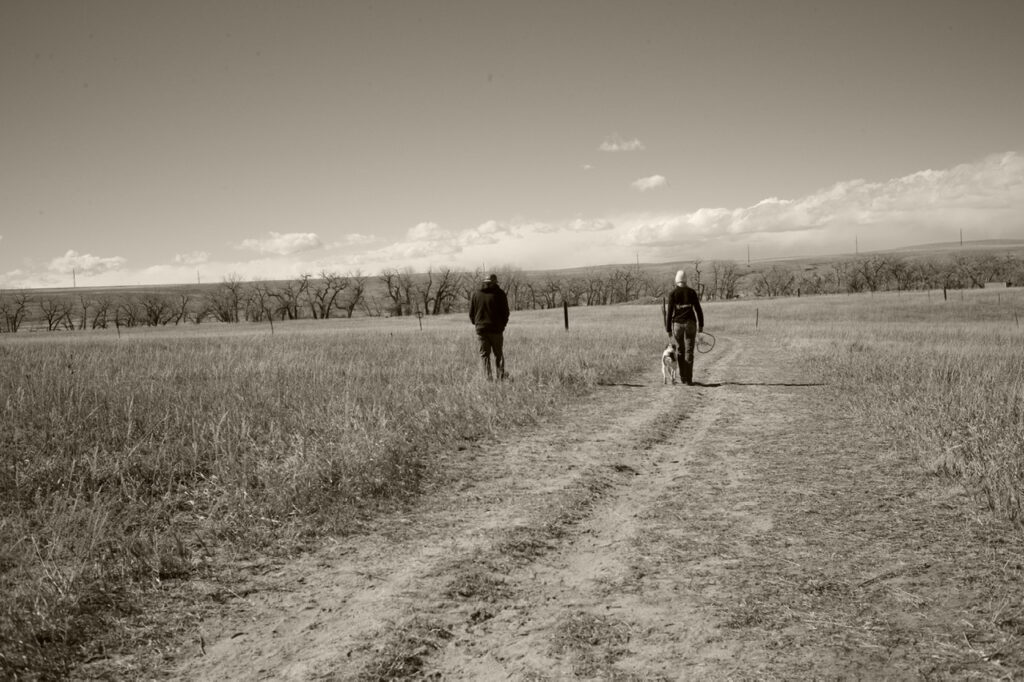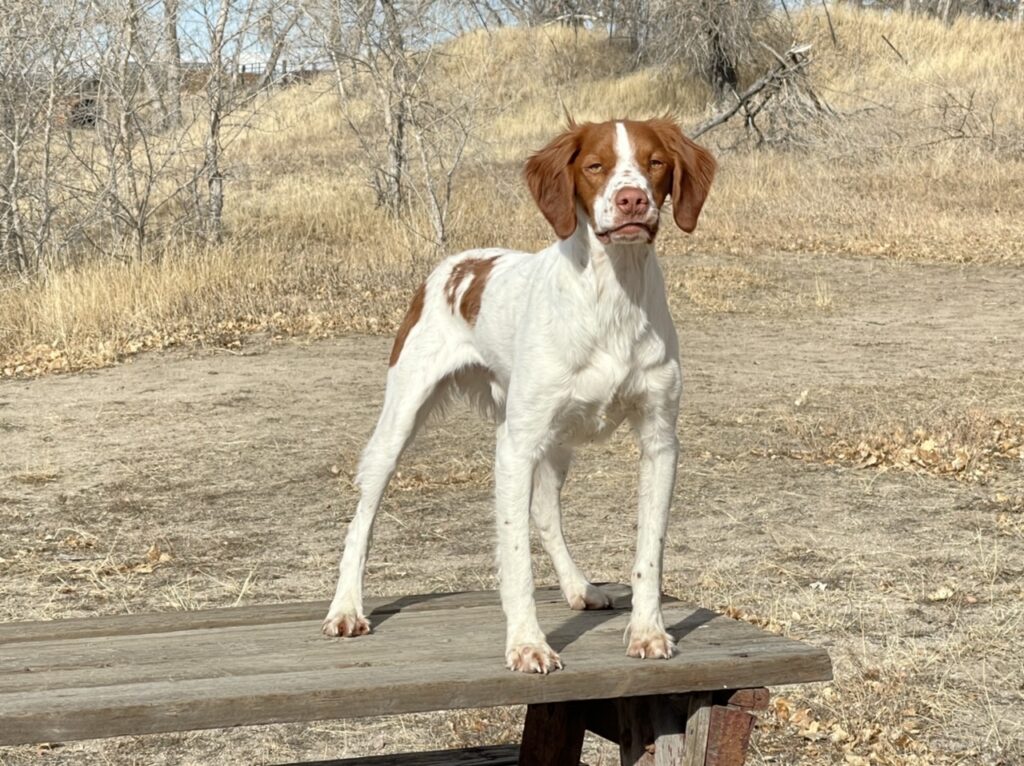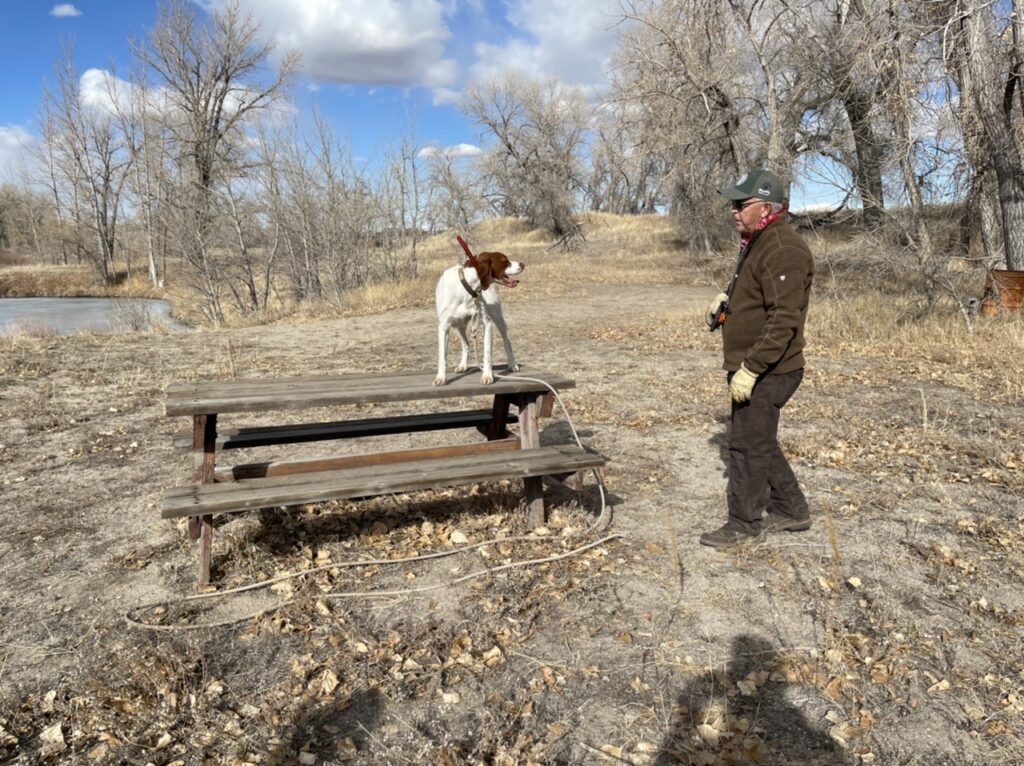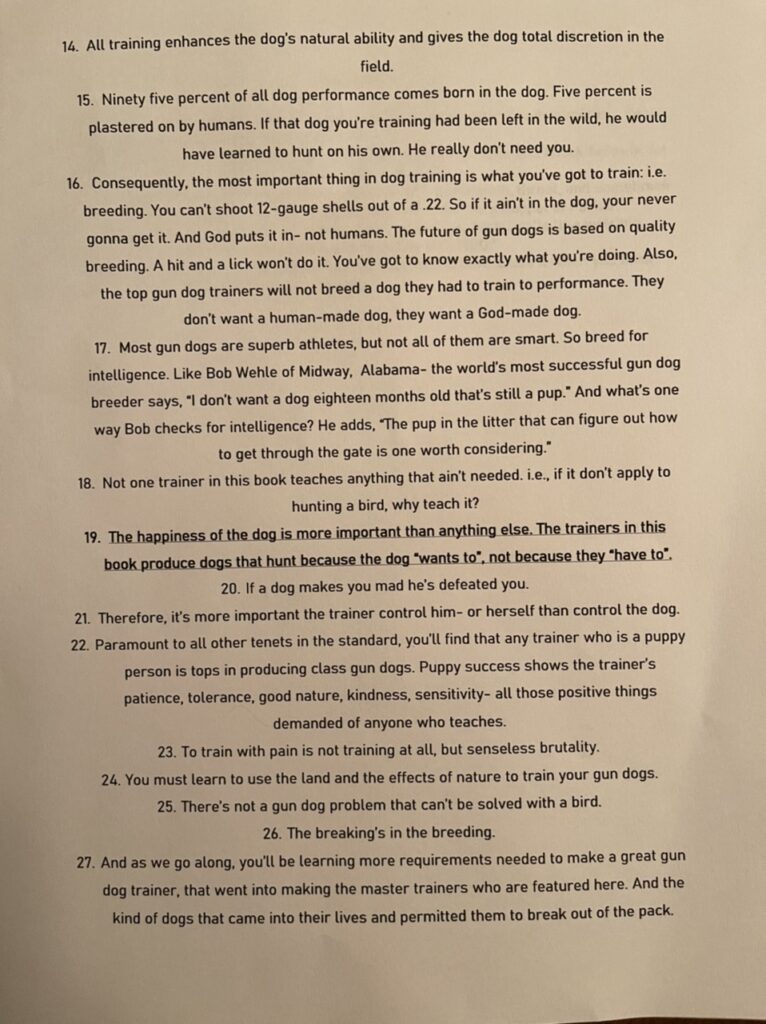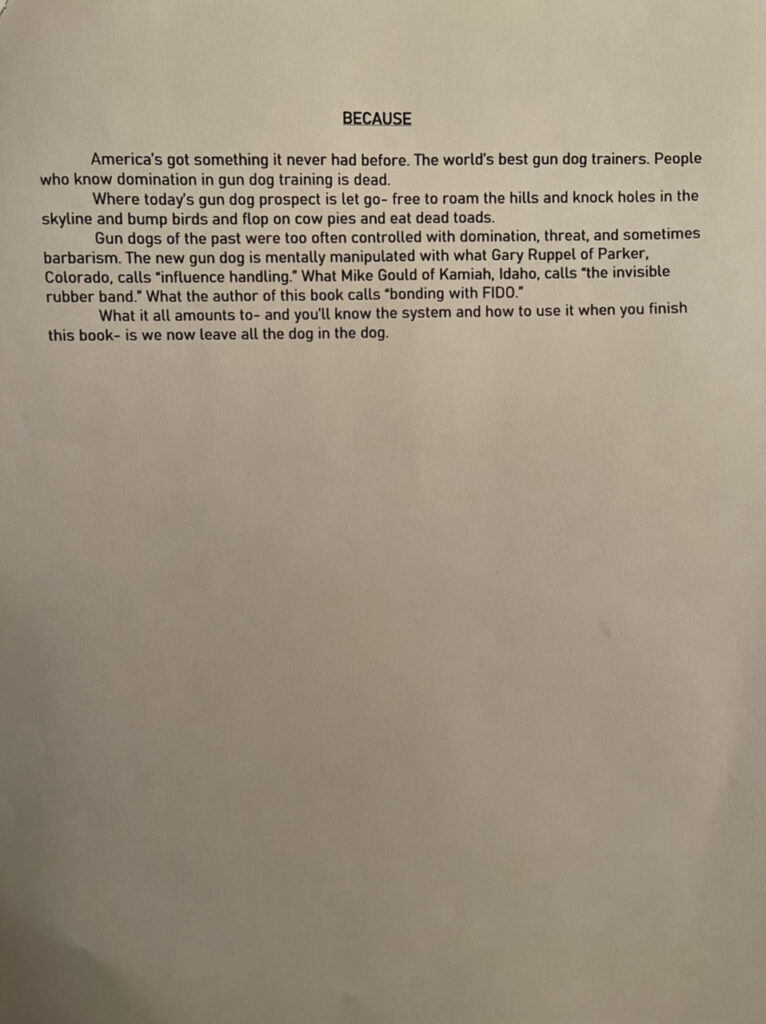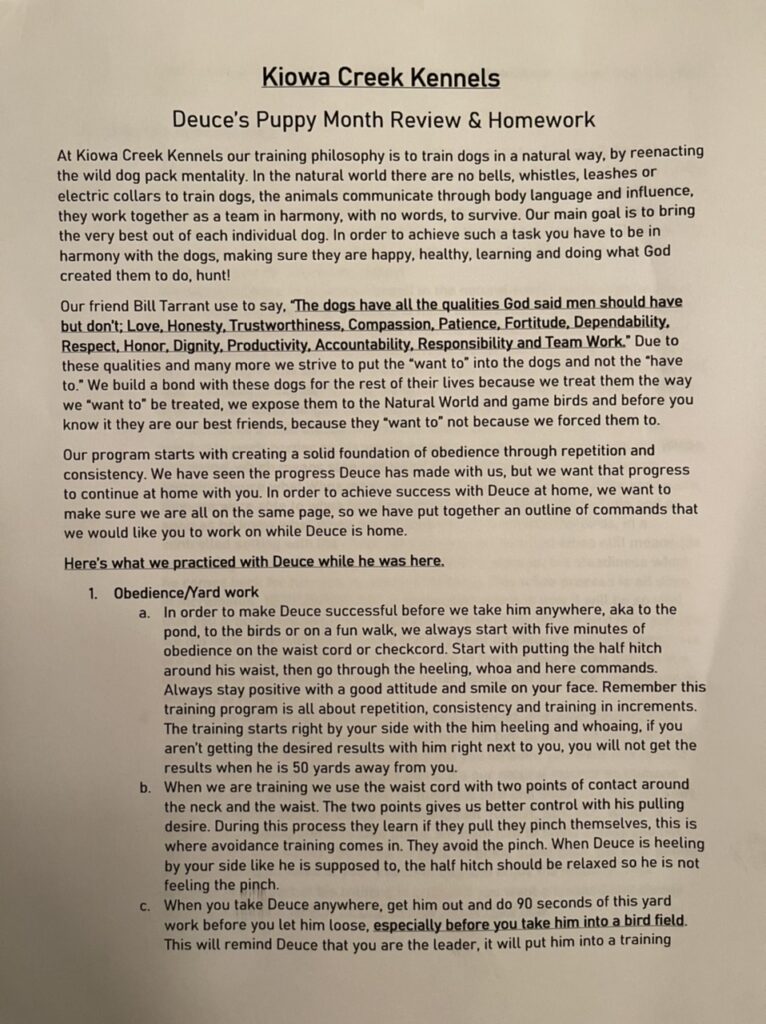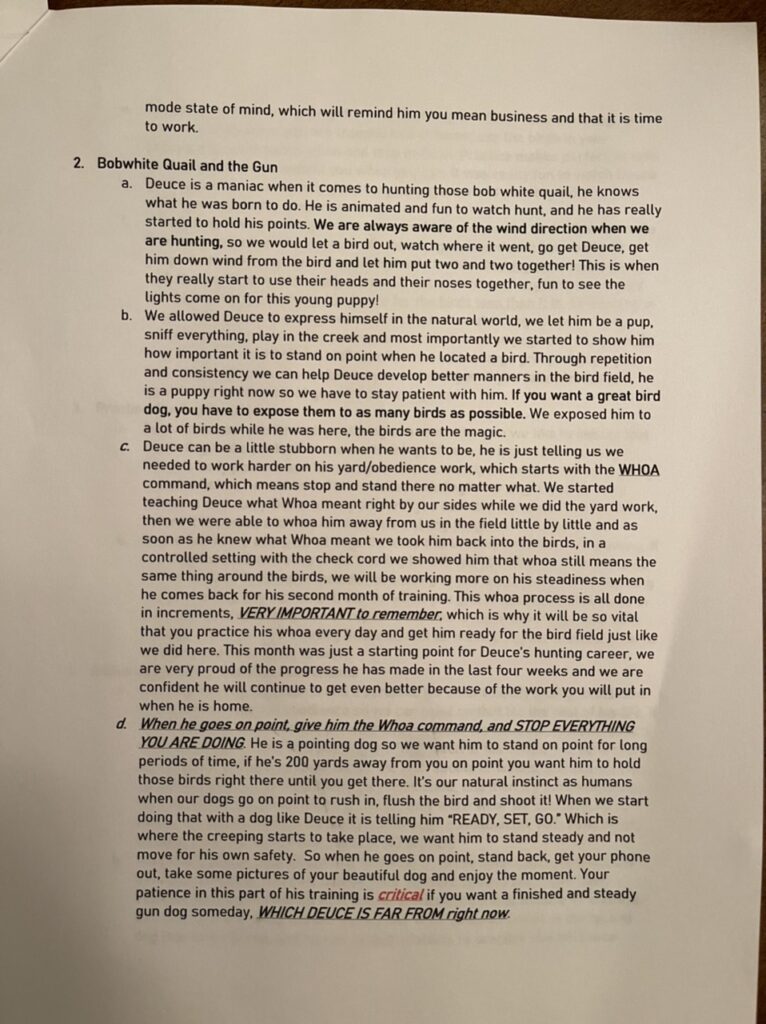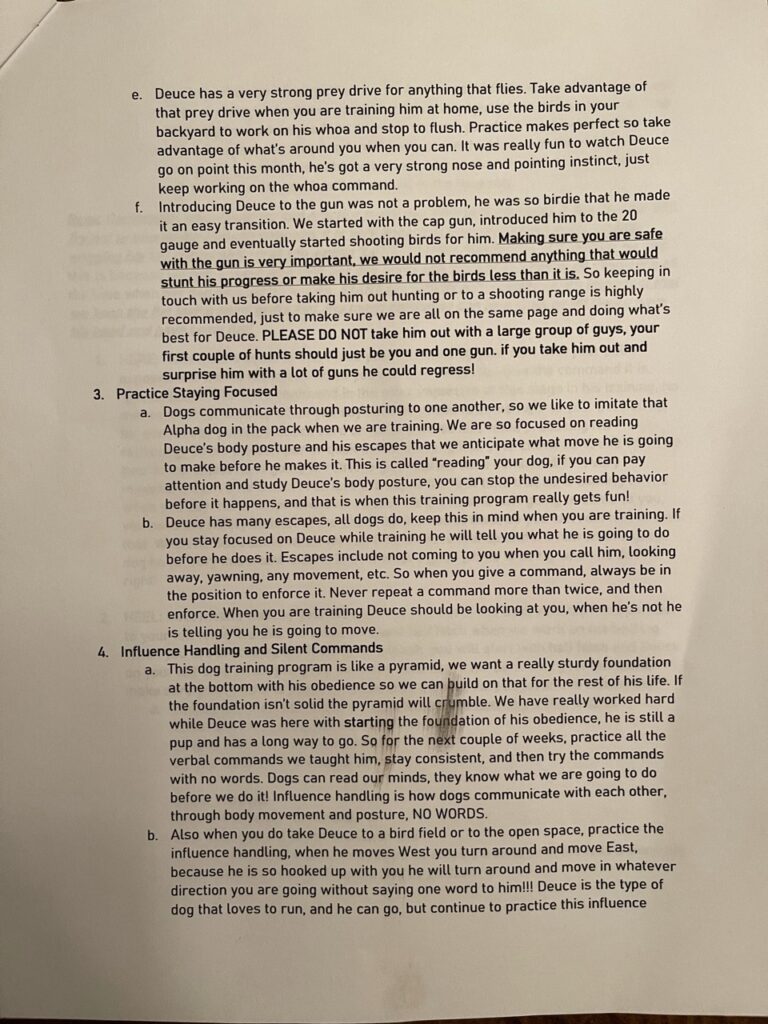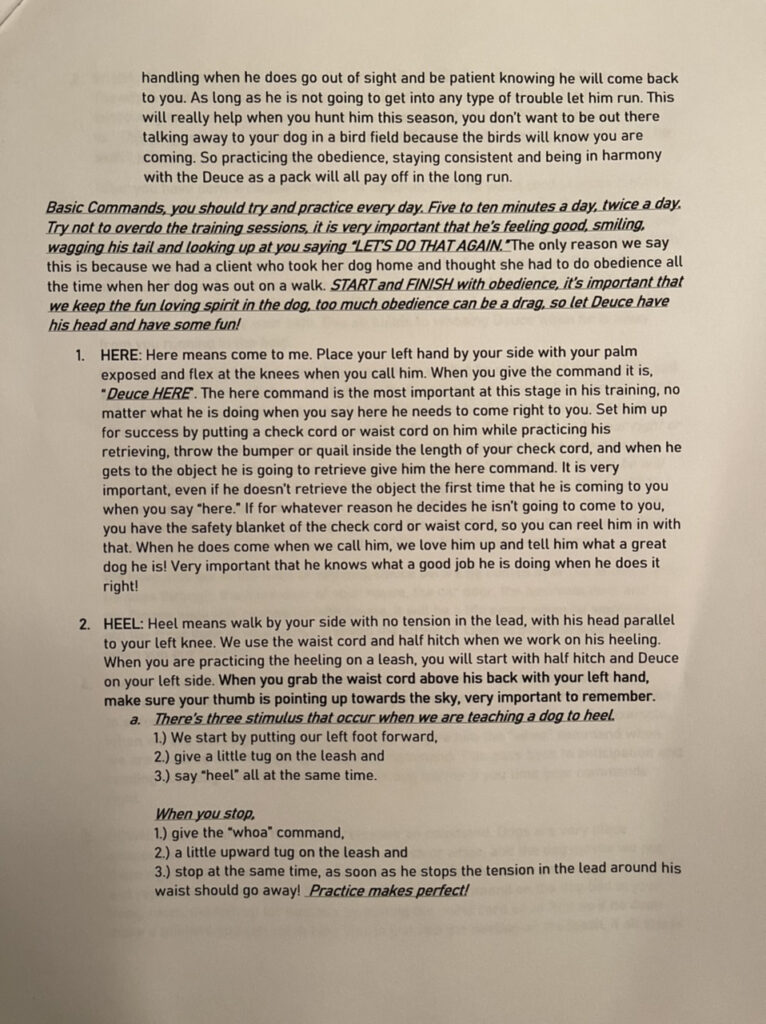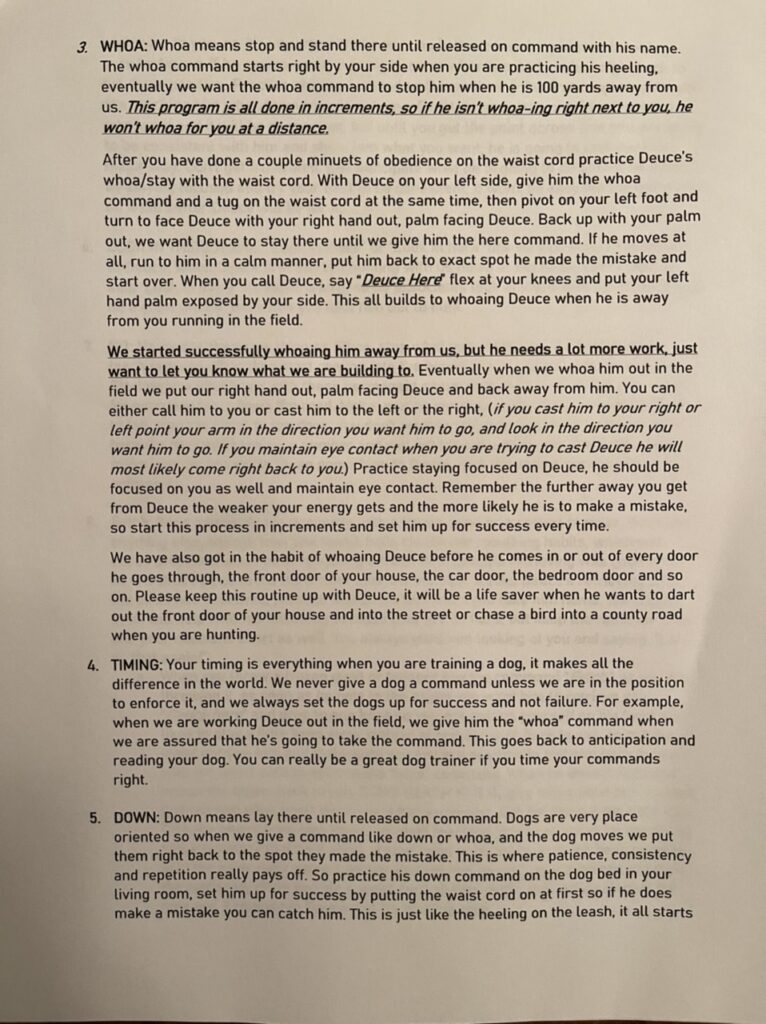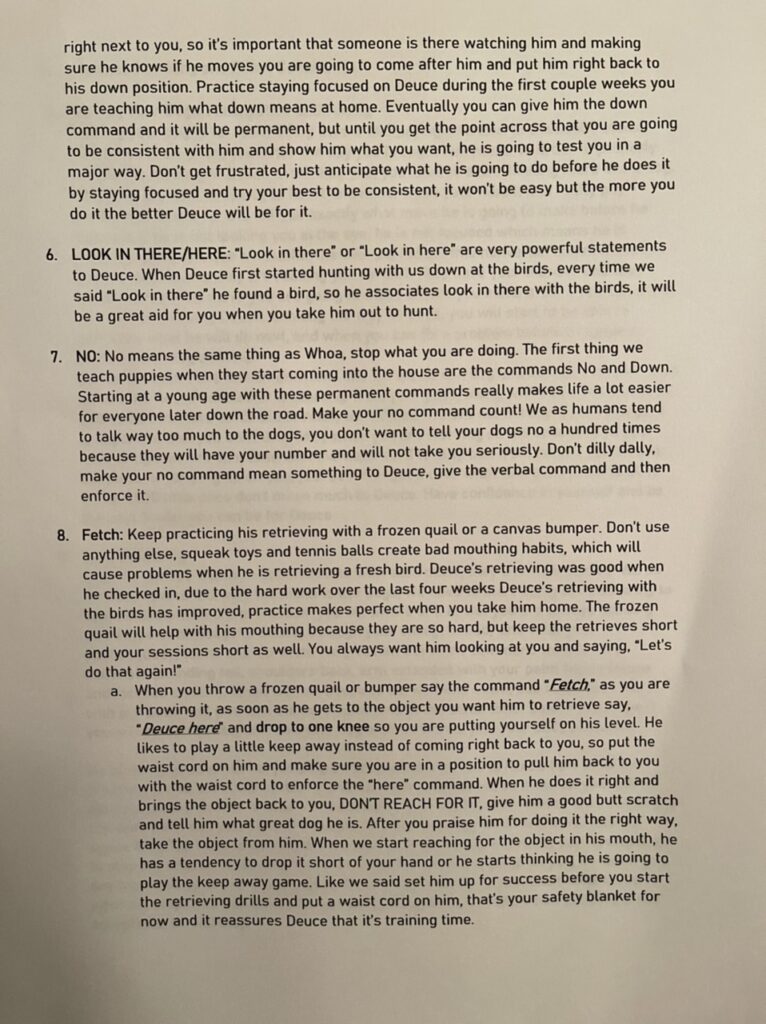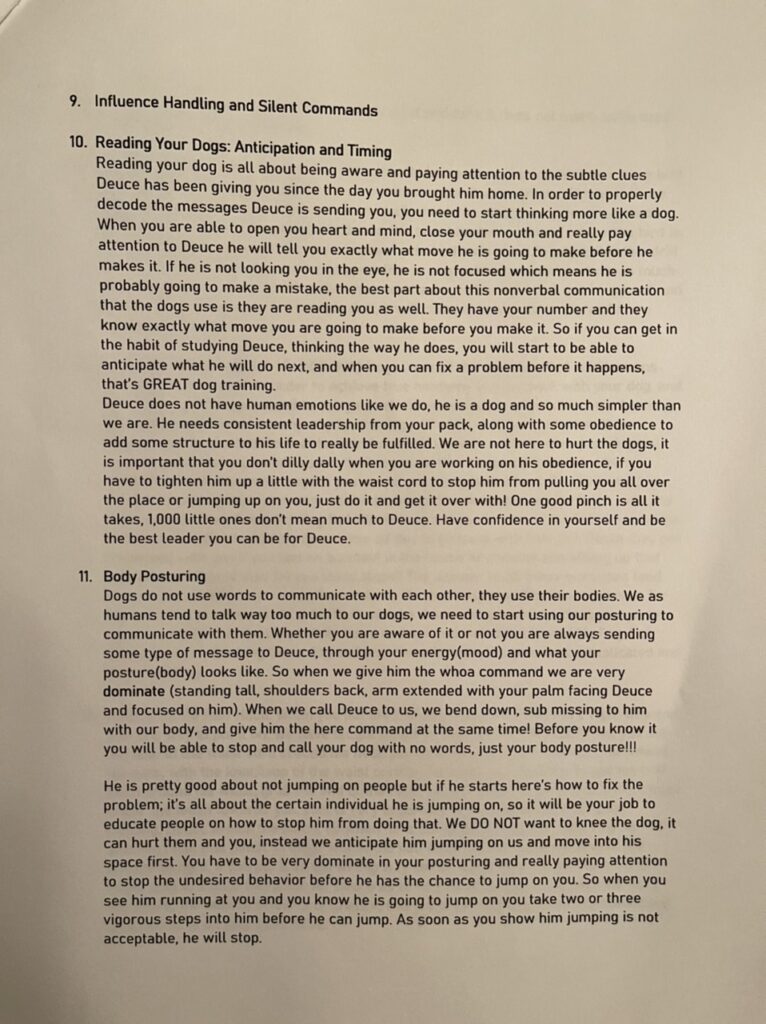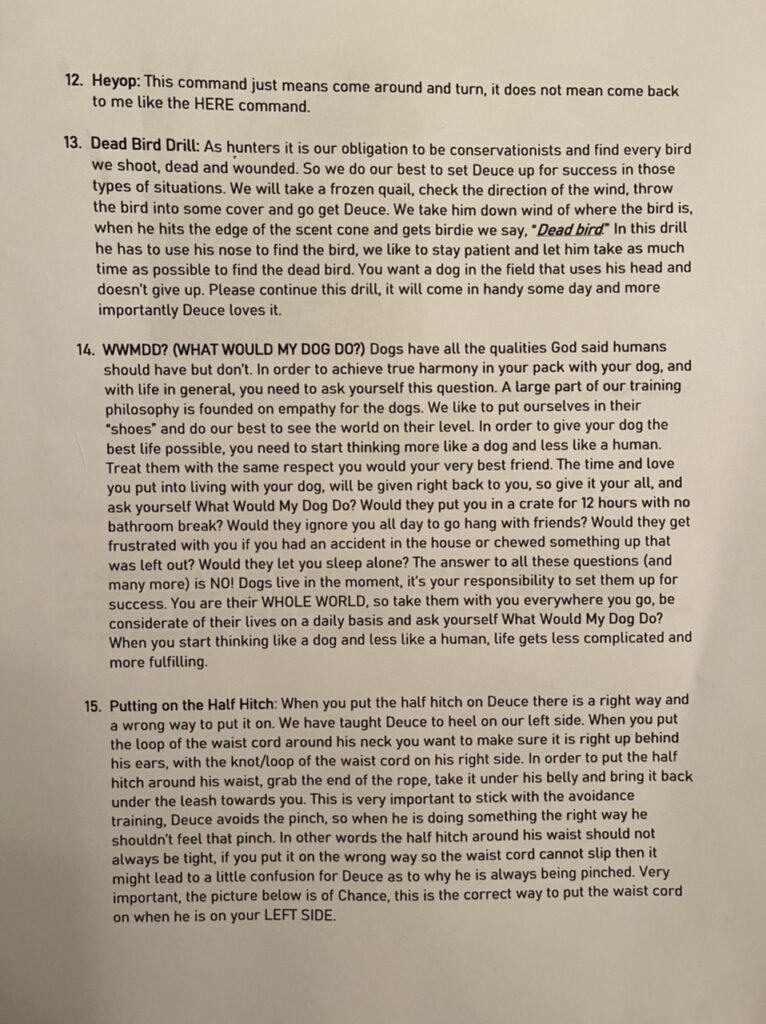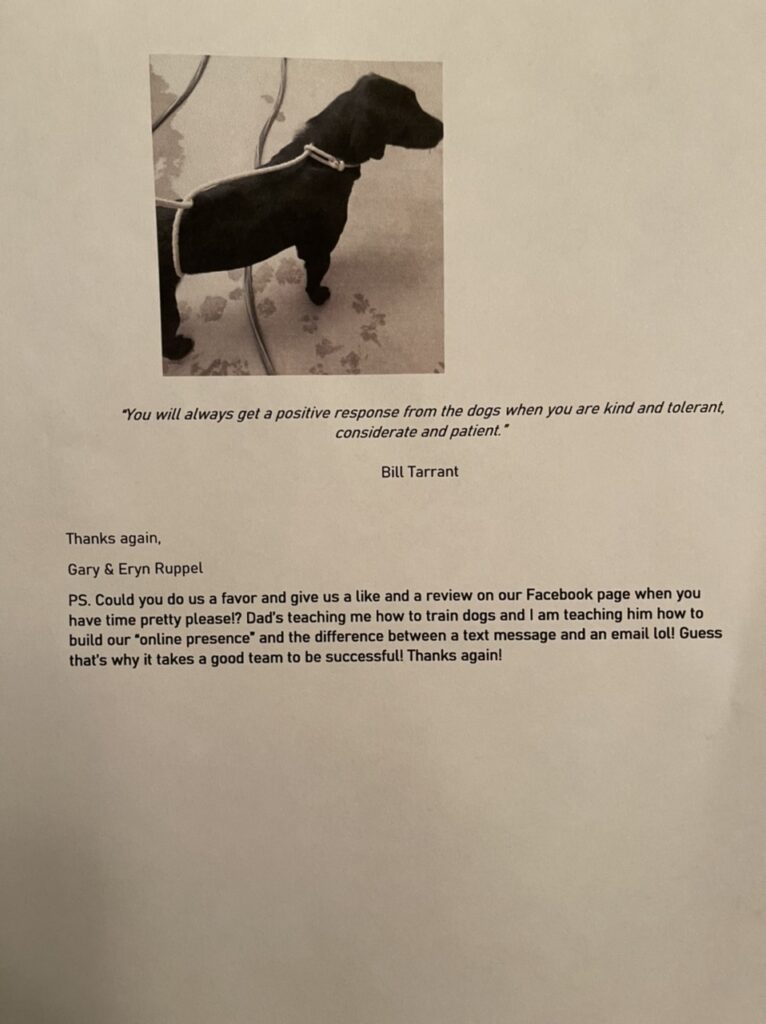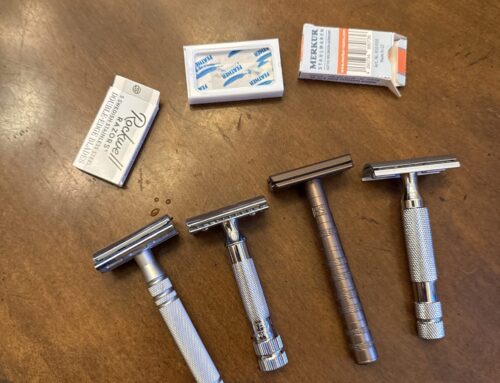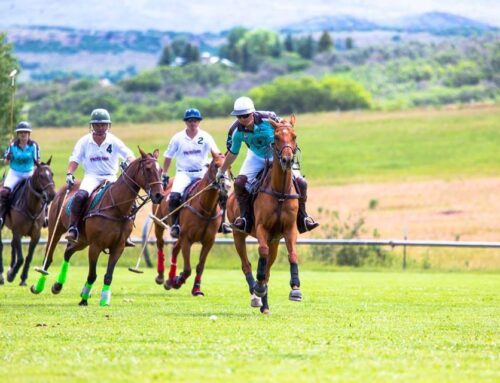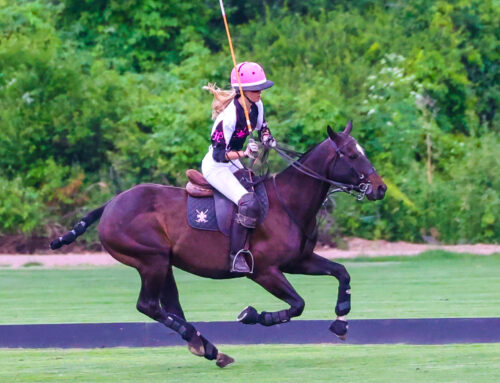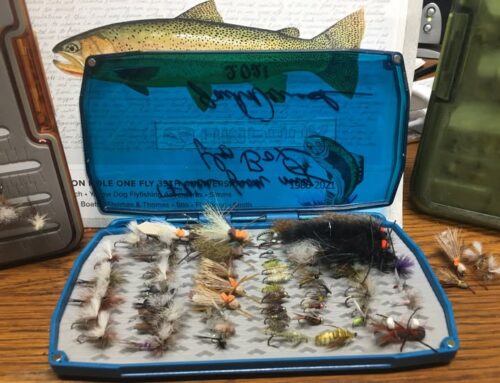Take a guided stroll with us through the evolution of dog training with this tribute to those who get their hands dirty and train dogs professionally in both good weather and bad. And, the best set of those hands, at guiding dogs to achieve greatness, are those of Gary Ruppel. Gary was mentored by Mike Gould, and both were written extensively about by the late Bill Tarrant for their extraordinary ability to connect with pointing dogs on a new level. Come step with me, through an invisible veil, deep into the secrets of bird dog training. It is my hope that you will find something here useful, not only for you, but for your bird dog.
To me, the joy of wing shooting and upland hunting is in watching the dogs work. If I didn’t have a good bird dog, I wouldn’t hunt. And, I prefer pointers over retrievers, but Gary breeds and trains both. Sure, the shotgunning part of a day afield is a beautiful thing, both in and of itself, and something I have spent a lot of time and money to perfect that craft as much as possible. But having a finely tuned bird dog is the real key to enjoying what God gives us from a day afield. Just enjoying a day in our safe space in nature and watching a dog run in the grand places in big skies, where our 14 species of upland birds are found, as are some of the most magical places in the United States, often wide open or undisturbed parts of the county, can set your heart right again in the world. So it is, that the training of bird dogs is a critical component of upland hunting, if not a joy in of itself, as it is a special kind of “practice hunting” for the dogs and for us every time you go out and work them on developing their capacity to be in tune with us.
What Would My Dog Do?
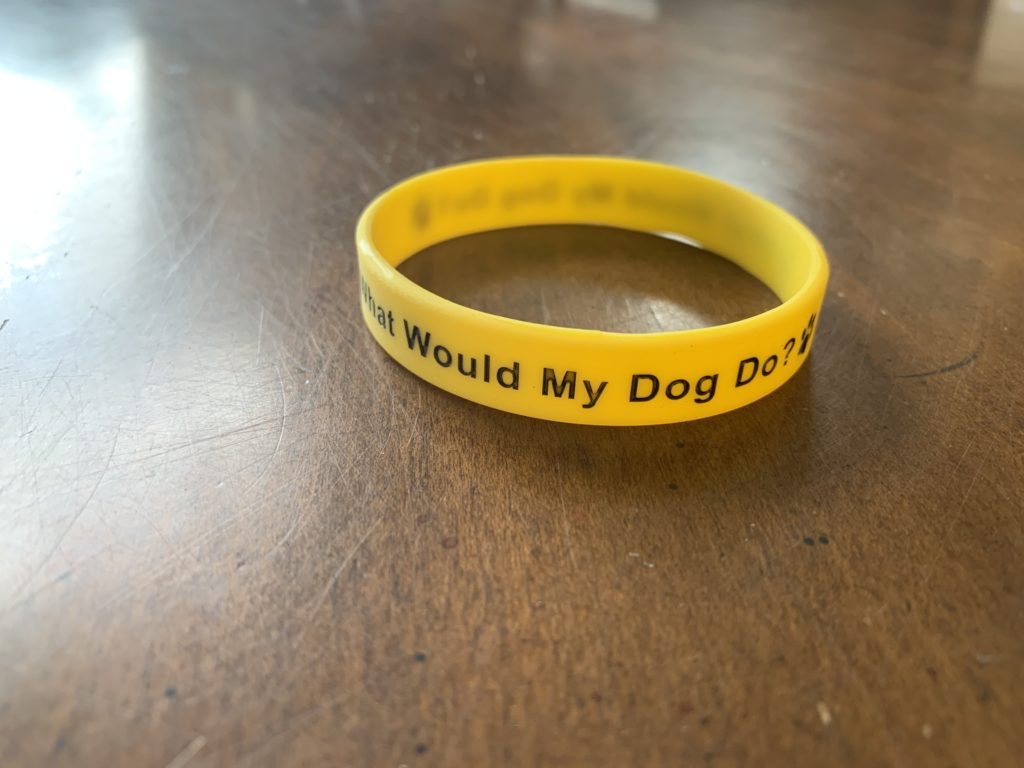
People generally find it difficult to think like a dog. And dogs don’t think like people do. They are always present in the moment, something we should strive more to do. Most owners assume dogs think like people. But dogs don’t talk to communicate with one another, they use posturing, which is a trait we have largely lost touch with in modern society. Because dogs do not use words to communicate, we can assume that they do not use words to think about their activities or to remember experiences, people or objects. But just as we do, dogs recall images, places and patterns of movements, probably far better than we do. In short, they are experts at mental imagery and repetition of developed habits. Dogs also behave in ways that reflect their feelings. It’s short sighted to think that they don’t understand the world a lot better than even we do. They feel, they adapt, they overcome. And they do so without a lot of focus on the present or the past. If you want to become as enlightened as the Buddha without sitting under a Bodhi tree, just consider for a moment, what would my dog do? If you can place yourself in that moment, you just might get a glimpse of what life has to offer, in each passing moment.
Great trainers look first to themselves as the source of any problems, then to the circumstances, and last to the dog. In short, we have to change our way of thinking to mirror theirs, if we wish to excel at training and, then in that moment ask ourselves, “What would my dog do?”
Training with the Best Gun Dog Trainer in the Nation
There are few experts who really know something that other people have not yet discovered, or have long forgotten, that we can all learn from and when you find one, you instantly recognize them as such. Gary Ruppel has been helping me train my bird dogs for over 20 years out of his Kiowa Creek Kennels. Before that, he used to train at a couple of our area gun clubs, where I trained dogs with him as well. Gary offers two methods of training, training the dog (drop your dog off at the kennels for a month or so of training, where you pay for boarding, training and birds on a weekly or monthly basis) and training the owner (individual sessions with the dog and owner, usually around an hour in duration in which you pay for time and birds).
Unless you haven’t spent the time it takes to bond with your dog and have a good rapport with him, I prefer the “training the owner method” or “training sessions,” which Gary notes is “much harder, as it is more difficult to train the owner than it is to train the dog.” And, this method is not really cheaper, it’s actually more expensive, because you have to go drive out there a lot to get in the 30 or sessions that you would have gotten for your dog if he had just stayed at the kennel for 30 days. But, you both learn in the process, which is why I usually prefer it, but I have done both with our Brittanys. Sometimes, the journey can be short, sometimes long, but it all begins with a single step, no matter how big or small that step needs to be.
I didn’t just select Gary as a dog trainer because Gary happens to live nearby in Colorado, about an hour from us now, but before that he was training at a gun club about 20 minutes from our house. In fact, I didn’t even know where he was located when I sought him out, after reading about him in Bill Tarrant’s books. I had read all of the bird dog training books, and I’d have sent my dog anywhere. I read. Everything.
As young lawyers, we are trained that when you are confronted with something that is unknown to you, you read all of the available precedent and then decide the best course, based on what others have done before you. For me, that involved read something like 50 books on bird dog training at the start of my journey. And since learning never ends, I have since read several hundred more. Pretty much every bird dog book that is in print and, then after that, nearly all of them that are now out of print. Then, as a lawyer, you compile all of the opinions and you see what makes the most sense for your situation. Gary’s method made the most sense to me, and it still does some 25 years later. I am now having more fun seeing our daughter learn from Uncle Gary, as much as I am in seeing what our bird dogs can learn from him. So the training sessions are two-fold. Sounds like a strange thing maybe, but bird dogs and teenagers are a lot the same. Letting them run a little wild and free with the guidance of a few wise old dogs, here and there, might just be the best way.
Gary was featured in about a dozen books, which are listed below. Then, back to my lawyerly analysis of finding a solution to a problem, after reading all of the prior cases on a given subject, you try out your arguments and see if they work in real life. Well, that is exactly what I did here. And the arguments in favor of Gary’s methods were compelling. And, seeing how they worked in real life, that was the icing on the cake.
I have spent over 100 hours with Gary in paid training sessions. I have left all of our dogs with him for a month to be started and dropped them back off for more training, whenever they need more extensive tuneups. And, I still go back to him many times, regularly each year, with dogs of all ages for tuneups as his timing and knowledge is worth the ongoing expense. And, more importantly, to tuneup myself.
What follows is my notes from training with Uncle Gary, as we affectionately call him, and these notes are solely intended as a living memoir for our daughter—-sort of a book of reminders if you will, and they are not meant to replace actual training sessions with Gary, which are still invaluable to me and her, even after some 20 years of training with him and absorbing all of his methods, and which I highly recommend to any bird dog owner.
But I am not blind in my devotion to his methods. To see what I may be missing out on with other methods, I have trained with a lot of other professional and amateur trainers from Bill Tarrant, Mike Gould, Jeff Hoskins (three of the most similar to Gary’s methods, and not surprisingly all friends of Gary’s), but also with others such as Ronnie Smith, Bob John, and I’ve had conversations about dog training with Bob Whele, Ben O. Williams, Dez Young, and many other experts. I have also watched most if not all of the bid dog training videos on DVD and otherwise, from Whele to Wolters, the Smiths’ Silent Command and George Hickox, Delmar Smith, Wolters to Joh Hann (who by the way is very similar in a lot of ways to Gary’s method), and then on down to just dog training in general, all the way to the Dog Whisperer, Don Sullivan and the Monks of New Skete. Anyway, I say all of this not to impress you—- but to impress upon you, that Gary’s methods really work and I am not just speaking from a small range of critical thinking about it. But, the best bet is to find a method that works for you and your pup—-and then enjoy the journey, as pup will teach you as much as you teach him.
When to Start Training a Bird Dog
I remember calling Gary Ruppel when I got my first 8-week old Brittany puppy, who came from very famous field trial lines at the time, and I told Gary that the field trial breeder had asked me to bring him back for “his summer camp” when he was four months old and just to acclimate him to our house until then. I asked Gary, “When should I come out and start training with you, in two months, when my pup is 4 months old?” I’ll never forget Gary saying, “You are already four months late, I start training them in the womb, bring him out tomorrow.” So, I did. And, I found no need for summer camp, as training became a daily part of our lives, in small and large ways.
Gary says that he starts training in the womb, like a mother begins to read stories to her unborn child. He said that he first bonds with the bitch, which is the foundation of all of his training. “If the dog doesn’t do it because he loves you, you’ll never really get the full potential out of that dog. You can do all the old methods of force breaking and whatever else you can think of, but a dog that it is doing something out of fear, rather than love, will never be performing at full potential.” He says, “My pups already have heard all of the whistle commands when they are born, as they have heard them in the womb.” He likes the Roy Gonia orange or clear whistles, and he says the orange has a slightly better tone, but the clear tone carries further. Take pup out, let him in the house, socializing and bonding with pup. Get them bonded with you. That is the first step.
He asks, where are you keeping your pup? And if the answer is in an outdoor run and kennel, Gary says, “Be sure to bring him in the house too, as he’ll never bond with you the same if he is always in a kennel.” Our dogs live in the house. But some don’t and that’s ok too, as long as they have time inside to bond with you.
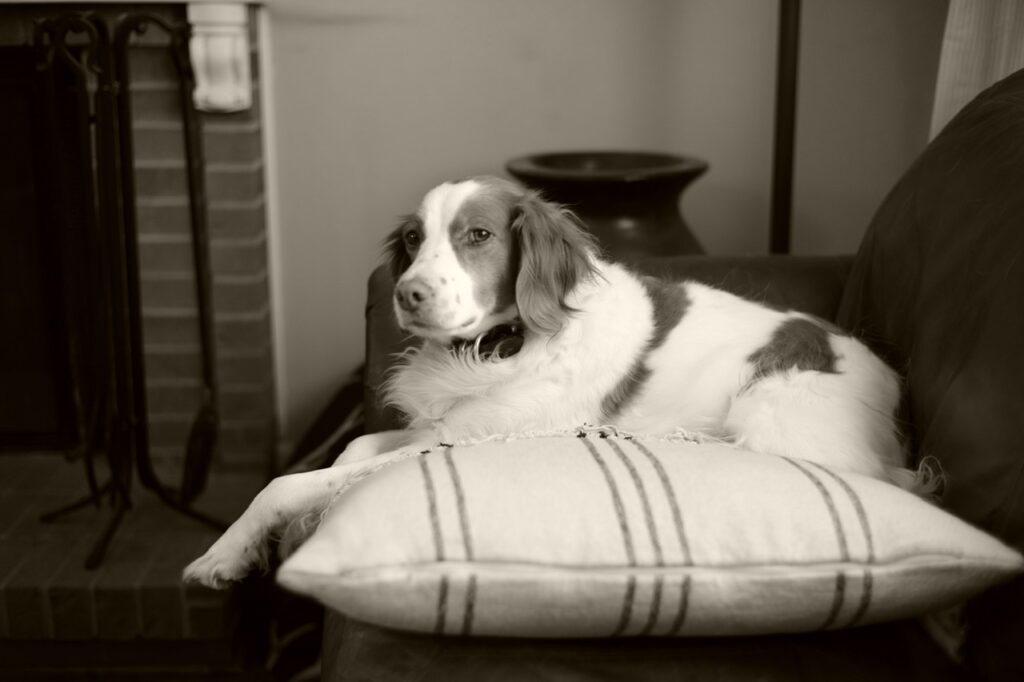
Gary has a small boarding facility and an especially large puppy welping shed/house with a big run (but built for only one bitch), and every time I have seen him with a litter of puppies, they are inside his house, in another special area there, but also at times running free through the house and occasionally I have seen him with one playing or sleeping on the bed. I wonder what the outdoor welding house is for, as it is rarely used. Gary says, “The first thing you have do when the puppies are born, is bond with them, socialize them—not only to their world, but to ours.” Get yourself a good dog crate and if pup is having difficulty sleeping through the night, you can try a hot water bottle in there under a towel and/or an old fashioned, cheap but metal wind up pocket watch that clicks like momma’s heartbeat and put it in the crate.” We did that, and it worked.
Begin Positive Conditioning Right Away with Pup
Once you get your puppy home, he recommends to “Begin positive conditioning to the whistle from the moment pup is born, if not from the womb.” Whistle while you start to feed pup. Gary uses Purina Pro Plan Performance, in case you were wondering about what is best to feed your puppy or your dog, there are may great options out there now, but this is one of the best.
Use the whistle to call him to dinner, tot-tot-toot-tot-to-toot-toooooottttt. This is the “here” command. Give him lots of love when he comes and get down on your knees on pup’s level. Soon you will have a pup that follows you around everywhere, because you are only doing positive things in his life, never anything negative at this age. Garry uses a “Toot, ta toot, toot, ta toot, TOOT, TOOT” cadence for HERE on the whistle. They are both used interchangeably, on the whistle and with the voice command. Also you can teach HERE in the house or in the yard, reinforced by a small handful of treats. A fun game of HERE can shared between two players with put, who take turns calling the dog back and forth, using intermittent rewards of an occasional kibble or just always loving on him. Do this by calling the dog’s name, then saying HERE, then crouching dog on the dog’s level to make his approaching you less intimidating. Remember dogs communicate with nonverbal posturing, so your posturing is more important that the verbal command. The word HERE is better than COME, as it carries better in the wind. You can start getting pup used to dragging a check cord as well, especially during this two person drill in the yard, and you can also use it to occasionally correct pup and reel him in if necessary. Keep the sessions short and fun, less than 5 minutes a day. Pup will be coming pretty well to both the whistle and HERE within a week or two.
You can also make this a two player game with pup—-we call it “the HERE game.” Grab a half of handful of kibble by each of the two people, and take turns calling pup by “his name, HERE” and the other person can use the whistle. As pup gets good at this, make the rewards intermittent and try hiding in different spots, making pup have to search a little to find you, as he gets better at the game. Keep it positive.
Sure there may be times when a pup needs to be scolded, but at this age you usually you just hear Gary gives the pup a little “Ahhh” in soft growling voice, if the pup is doing anything negative or unsafe. This carries over when they get older, you just give the same command “Ahhh”—-which Gary prefers to “no” unless there is something really unsafe going on, in which case he still rarely uses that all too common NO word, in favor of a louder and longer “aaaaaaahhhhhh!” Again, dogs don’t use words to communicate, so this is more natural for them.
Having said that, Gary is very quiet in the field. Very quiet. Ninja quiet. Like almost silent a lot of the times And dogs still look to him for influence. This is what Mike Gould calls the “invisible rubber band.” When dogs hunted in packs in the wild, they didn’t talk to one another, yet they were in constant communication in order to be successful in the hunt. So this is already imprinted in pup, you just have to learn to be the leader of their pack with these nonverbal cues.
“Preferably, you should get to the perfectly trained point with pup where you have to say nothing to the dog, EVER—-especially if he’s doing everything right,” says Mike Gould.
The dog should be reading you, and you reading the dog. Dogs communicate through posturing, and they can read ours, we just have lost the ability to do this with others, which this method seeks to have you rediscover. If you really think about it, dogs don’t communicate by speaking, almost never. Sometimes a growl from momma dog as a scolding, or a playful yap, or an alarm bark but, they don’t rattle on with various commands to each other. They also don’t do this to greet one another. You shouldn’t either.
Be sharp and short on commands, and once is enough, don’t repeat commands—- but you have to be in a position to enforce the command, in location of the pup or the check cord. Nothing is worse than a bunch of yelling commands with no enforcement of them.
Posturing is More Important than Verbal Commands
Gary prefers subtle hand and body position commands and reinforces those often when in a position to influence pup’s handling. A flick of the hand to change direction, sometimes coupled with two short toots on the whistle, perfectly timed while pup is looking back at you, then striding off in the new direction, maybe with a quick tug on the check cord. A little encouraging “look in here” with a flick if the palm, when birds are close. This LOOK IN HERE is reinforced with a lot of birds. When training, LOOK IN HERE means pup always finds a bird. So, later you can use that when hunting.
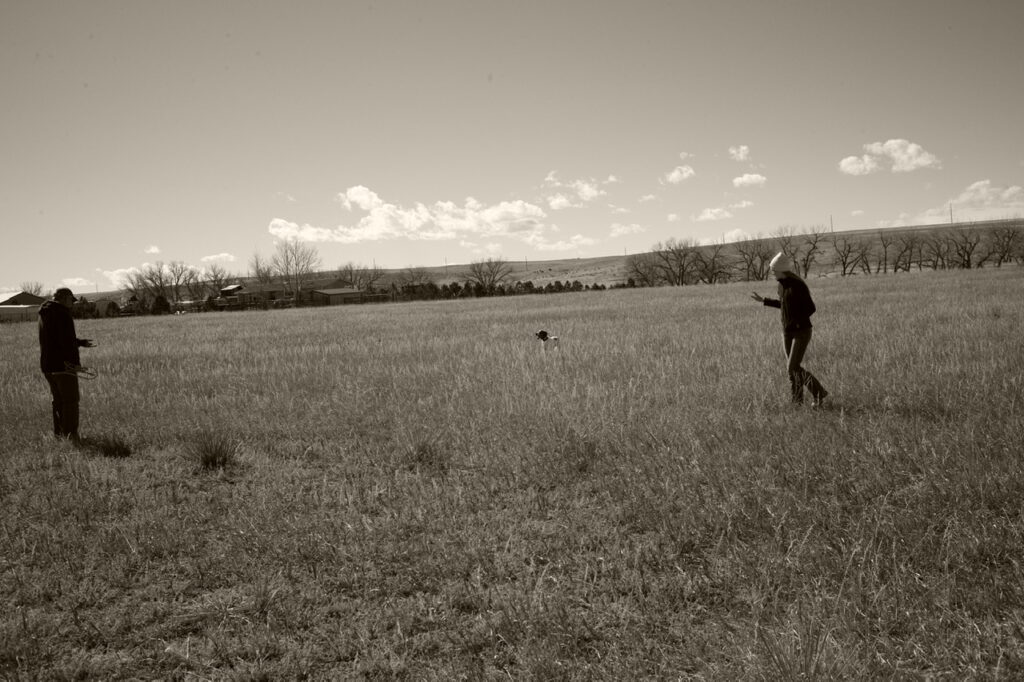
Crouching down on one knee, while turning away from pup, possibly with a “here” or a trill on the whistle “Toot too too, toot too too, TOOT, TOOT,” if pup didn’t see you, can be used to encourage a retrieve.
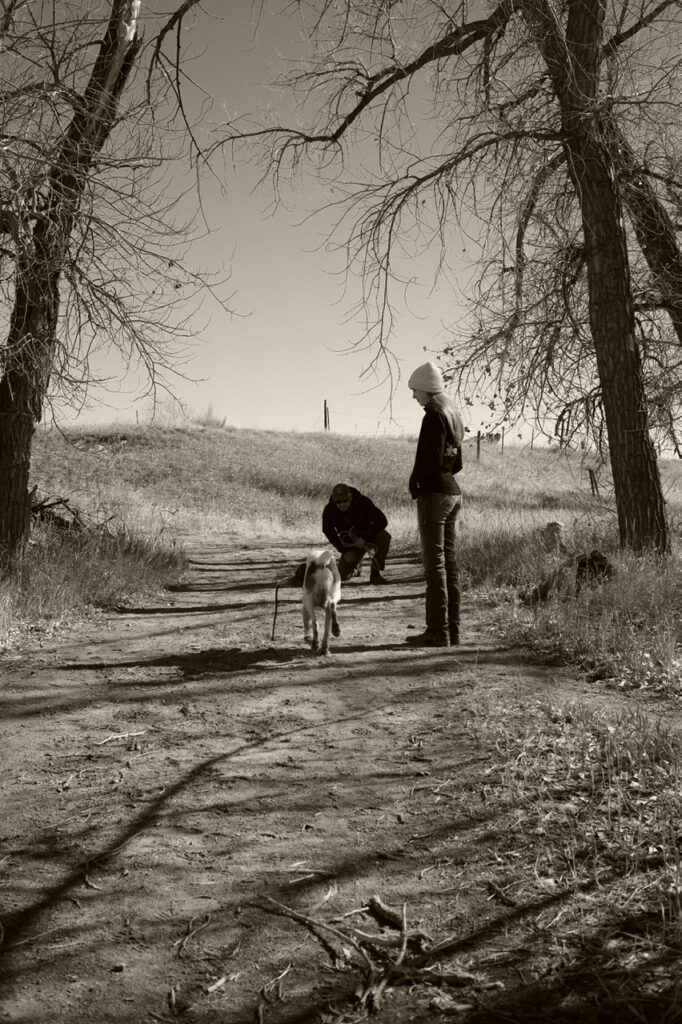
Two toots can be taught to pup or HEYOOO—-at times of desiring a quartering movement, as a “try over” type of command, rather than demanding pup to come here. You can do this with the assistance of a long check cord if necessary. But with a lot of birds in training, the check cording method is often unnecessary, just a HEYOO.
Gary doesn’t say or whistle much, but his body position changes the same every time he says something. Again, pup is more influenced by posturing than vocal commands. Look at trained guide dogs for the blind or seizure dogs, if you want real proof of this fact.
Later in Gary’s bird dog training progression, it becomes just the posturing, as dogs become better trained, and little voice or whistle commands are used. A step by the handler in a given direction or a flick of the hand to come or look in here, is more noticed by pup than all the yelling in the world.
You only see Gary give a rare yelling of WHOA at older dogs who break point to flush and chase birds or other high crimes. And an ocasional soft and high-pitched babbling of praise perhaps of ATTA BOY or GOOD DOG, especially when praising and petting pup for jobs well done retrieving, or after everything was done right from, point, shot and retrieve.
Gary prefers operant conditioning with positive reinforcement whenever possible, over old school yelling of commands, “breaking methods” or E-collars. There is a better way for pup to be trained nowadays.
A fully trained bird dog requires no verbal commands or e-collaring, you’ll have to see it to believe it.
But, I can assure you that this method works, and it works better than all of the other methods I’ve seen—-without any of the numerous side affects that are sometimes seen with old school methods in terms of blinking, shyness and other undesirable traits. And, once you see it, it’ll carry over to how you relate to and motivate your children and employees.
Positive operant conditioning works better than compulsion methods, nearly everywhere in life—-if you want proof, just look at the success of the Love & Logic programs. Our daughter is now influenced more by a short and occasional “ah” or a “attaway” than most kids are by paddlings or buying them a big reward from the toy store—-because she’s been conditioned to the positive reinforcements she receives for years now.
It starts to change your life and I really believe now that raising a well trained pup is very much the same as raising a compliant child—-having trained dogs for 20 years with Uncle Gary, as you’ll find that it rubs off into a lot of other areas of your life. But, that said, I have occasionally seen Gary correct a stubborn dog harshly with a check cord or a swat on the butt and I once remarked “That was a little rough for you” and he replied without pause something along the lines of, “Better to bite hard once than nip a thousand times—-look what mamma does to badly behaved pups, they don’t nip.” He is firm, but fair when turning to the occasional compulsion methods. And, they are rarely needed with his method.
It’s All in the WHOA
For pointing dogs, Gary recommends that you do not teach “sit” until much later in their life, if at all. It can stifle drive and make great sitters instead of great pointers. Further, he begins by teaching “whoa” or “whoooop,” as Gary usually drags out this drowning command for more carrying power in high winds, but it can also be just purred by the hunter to encourage steadiness on a nearby point. He usually starts by teaching this WHOA in front of the food dish as you set in down in front of the pup, where it is used like a wait command, until they are released to dig in eating by a soft, “ok.” And, in leaving the crate, door, and many other daily situations.
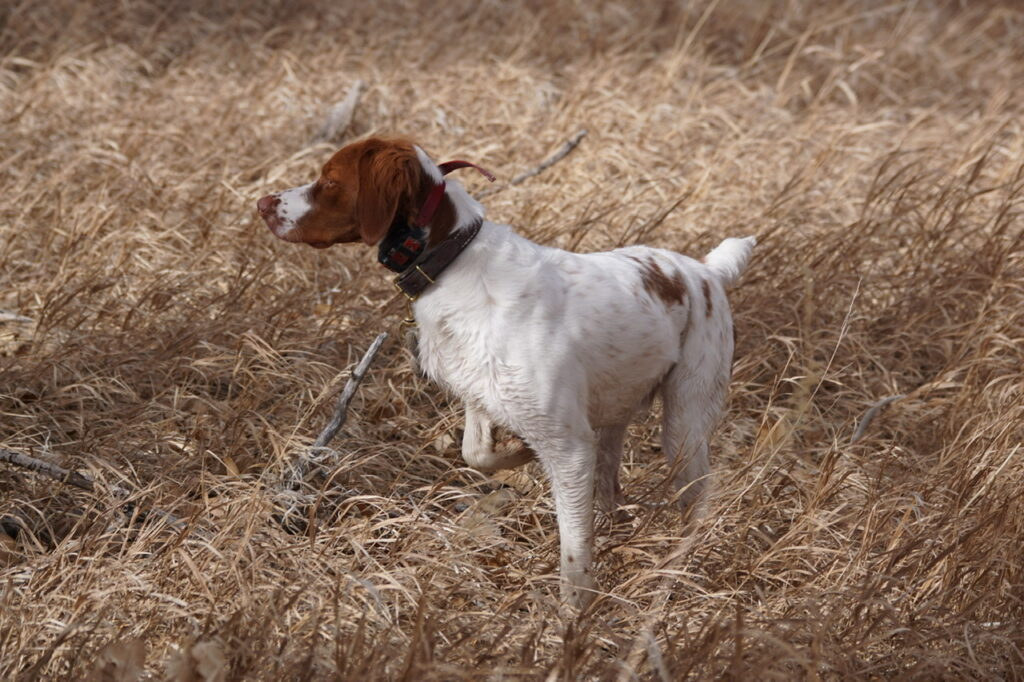
Encouraging the Natural Retrieving Instinct
For retrieving, Gary uses some frozen birds and bumpers occasionally, but for pup, he says, “Take an old sock, you know one of those ones you should have thrown away 10 years ago, and stuff it into another one that is missing its mate. Now you have a little puppy sized dummy that you can tie off on the loose end. Use this sock dummy to begin teaching retrieve.” Or, use a Crown Royal bag, he says.
Gary must keep his socks in a drawer and have a wife that never sorts laundry on the basement floor, as my socks are in the bottom of my closet and occasionally scattered around the basement floor sorted for the laundry loads. Having subscribed to his sock dummy method for 20 years now, I have recently switched to a little purple Crown Royal bag stuffed lightly with paper towels, which makes a little puppy sized dummy bird shape. This prevents having a pup who later empties your closet floor and laundry room, scattering your socks all over the house.
If you do the stuffed sock method and you like to keep your socks in a mess on the closet floor as I did when I was a bachelor, you should probably first call Gary’s wife and see if she has a sister, as your wife won’t be happy with all of the socks in your house being chewed up when you leave the door open one day. Unless you have Gary’s saint of a wife, using something soft other than a sock might be better. But then again Gary probably doesn’t leave his socks laying around like I do, as he’s a very organized guy. A frozen quail also works great, but again you got to have a patient wife for that sitting in your freezer every day, which I have regulated one drawer of the freezer to nowadays. A note—frozen quail for retrieving only works until it gets too mouthed by pup, otherwise they won’t pick it up, and then you need another fresh one. Or, you can try a puppy sized bumper with a quail wing tied around it.
Take your little soft puppy sized dummy, whatever you have constructed it from, socks or otherwise, and begin by tantalizing it in front of the pup waving it around like a bird fluttering, until he shows interest. Throw it a foot or two and say, “fetch.” Hopefully, he will chase after it and pick it up in his mouth. “This game works best if you sit Indian style on the floor, as it is a submissive posture and puts you at pups level,” recommends Gary. “It also should first be played in a hallway, with all the doors closed, as you want to set up an environment where the puppy has no choice but to succeed at the game by coming back to you with it. He will be forced to come back down the hall sooner or later, so you really don’t have to say much, Gary says. “We are trying to encourage a natural retrieve.” When the pup picks up the dummy, at that very instant, and not a moment later, say, “here,” as training is all about timing and the cue of the command at the proper instant is what you are looking to achieve. If you wait a second later, when the pup has it in his mouth and the excitement of chasing it down the hall has now set in with a little self-important feeling of having caught the prize, he may think he is being punished by the “here” command, which results in his stopping, dropping it, and/or coming back without it, and hence you have perhaps unknowingly broken the natural retrieve that we are looking to encourage.” So timing is everything with this drill and everything in dog training. One second too late and it’s like kicking a horse to go after it’s already set off at the pace you want, and it then teaches a reaction beyond the one you’re looking for. Gary says, “By training one behavior in a dog, we are always untraining another, so be very accurate on your timings.”
Honing the Pointing Instinct
Gary also likes to begin to encourage the pointing instinct with a wing and rod. “Don’t do it every day though, as you can over do the wing and rod, just once or a twice a week for 5 minutes or less, just to keep his pointing instinct sharp. You can gradually increase the length of time you let them stay on point. When they move forward to break the point, flick the wing so it flies. The pup will usually come to understand this game very quickly and may try to sneak or creap up to the wing. You don’t want that either, flick the wing and make it fly, the exact instant when that happens.” This is a short lived game and is best used only around 2-4 months of age. Once a pup begins to point birds on scent, you have to give up sight pointing the wing, otherwise it’ll encourage pup to move in on scent until he can see the bird, which will develop into a creeping problem that gets more difficult to fix later on when we teach WHOA.
You can start to introduce quail or pigeons to get pup excited about birds at around 8 weeks of age. Pup should show interest in pointing and chasing the birds. Let him catch one, maybe one that you have wing clipped. The instant that the dog picks up the bird, which you can make easier to build his chase instincts by throwing it for pup after crossing the wings behind the bird’s back or removing some primary flight feathers (at this young age and only initially, not when pup gets a few sessions older), walk away from the dog and then kneel down, together with whistling or pup’s name and “here” to encourage him to come. The walking away seems to entice pup to come see why you’re not chasing them to get their new prize, and they end up bringing it right to you, instead of engaging in a long chase of keep away, as dogs do with each other over bones. “Keep it fun, everything should be fun at this stage and I say very little to them in the way of training. I just love on them and make a big fuss when they do things right,” reminds Gary. “I don’t like tennis balls for retrieving, they create dogs who mouth birds too much.” And, lastly, “never reach out for the object they just retrieved to you. They will either run away from you trying to grab it away from them, or they will become mouthy. Or they’ll just drop it. Let them bring them to you, love on them until they are ready to hand to you or lay it in your lap, where you can slip your hand down at the exact moment when they are ready to drop it.”
With this method of teaching the natural retrieve force breaking is usually unnecessary later on. Gary says, “I haven’t had to force break any of my dogs for years now, I’ve learned to fully develop this natural retrieving instinct. If you condition them to the check cord as well, you can just slowly reel in the dog who likes to take off with his birds.” If you do have to do force retrieving training later on, you’ve screwed up, and the Delmer Smith toe rope, whoa table and ear pinch are nearly identical to Gary’s methods for dogs that were not properly encouraged to the natural retrieve. Though he says he hasn’t had to resort to that for several decades now.
Pup is Now 4 Months, What’s Next
At around 4 months of age, the pup should know his name, have a strong pointing instinct and be retrieving naturally. Here is when Gary used to move the training to nearby a sporting clay range or skeet field where people are shooting. Start a couple of hundred yards behind where the shooters are at, such as the parking lot or opposing end of the facility. Start to play with a quail or pigeon with primary feathers removed. Let your pup point and chase it. Or, if you have a natural retriever by now, which you should, you can play a little game of fetch with your sock dummy. Start to move the game gradually closer to behind the shooters. The idea is to move closer to the gun shot sounds, while playing a distracting game that the pup enjoys. If the pup pays any attention to the gun noise, move your game further away. Try this on successive days for 3-7 days and you should be able to progress to a point where you are playing the game right behind the shooters. Don’t rush it, or you will have a gun shy pup. If it takes a month, then it takes a month. If you get there in 3 days, great, but there are no ribbons awarded for rushing this process and if you mess it up you will have months and months of work to try to undo the results of your haste. Keep the sessions short, this is a 10 minute sort of game each day, at most. Now he does most of this with a starter pistol a good ways off from pup with a helper, in much the same way.
Introduce your pup to barbed wire fences on the lead taking him under. Do this many times over many days so that when he takes off in hot pursuit of a bird, this is a well ingrained habit. Same thing with ponds and creeks. Do it on a warm day and make it a nice reward at the end of a hot training session. You might throw a dead bird a few feet out and encourage him to retrieve. Make it fun. At the height of my dog’s career, my Brittany jumped in the freezing river to retrieve it downed pheasant. He missed time the jump and the bird passed and by by like 20 feet, by the time he swam to the middle of the river. He swim after it vigorously downstream. But it was no use, the bird kept floating downstream faster than he did. He swam back to the bank and clambered his way up. He ran down stream on the bank until he was 20 feet in front of the bird. He jumped back in, but this time time in his swim to the middle of the river just in time to intercept the passing bird. This is obviously not how you start but that’s the kind of willing retrieving you are aiming for in a pointing dog. Gary often goes swimming with pups encouraging them to join him in the fun. Take your pup to Petsmart… and McDonald’s.
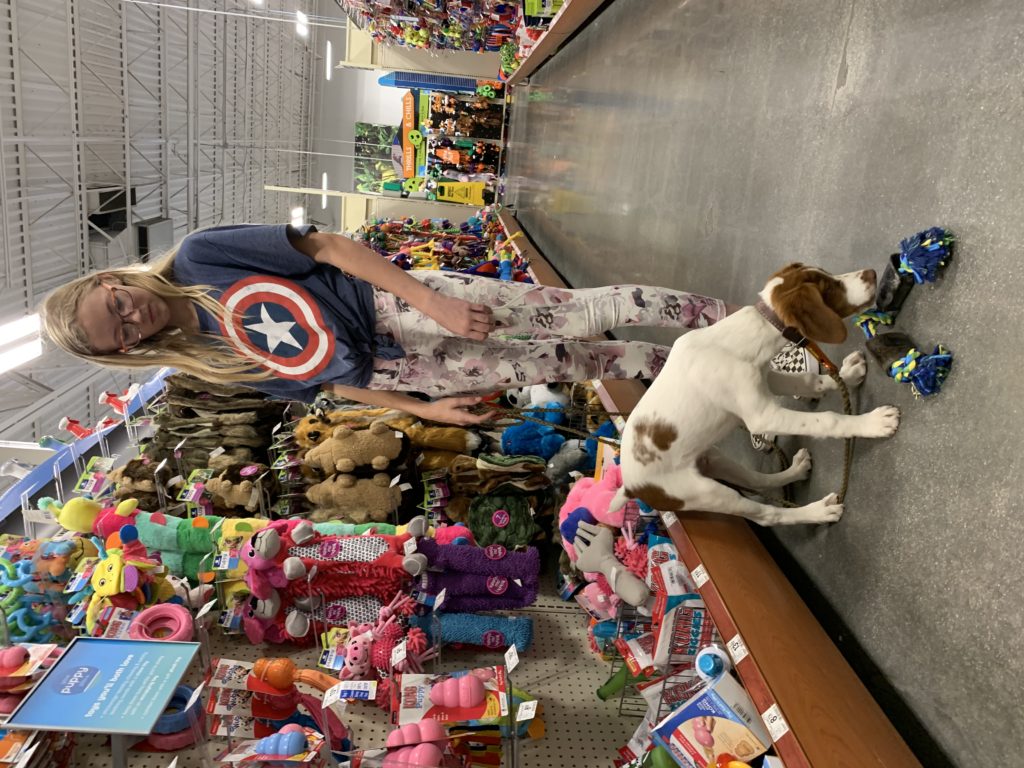
Take Pup to PetSmart, McDonald’s, the Pond, and Everywhere
Gary recommends, “Take your pup to Pet Smart, too like other dog owners do, as we are looking to have a well rounded gun dog. He needs to be exposed to everything that is going to be in our world and his world. Take him on a short drive to McDonald’s and get him an ice cream cone, especially if he gets car sick on longer rides. Expose him to other dogs, different types of country, logs, fences, barbed wire, streams, all of that he needs to know when he grows up. Take it easy and make it fun, don’t over face him with things that are too scary. Build up to bigger challenges. Start with just walking him on a football field or open field. Let him range where you want him to be when he grows up, if you want a 30 yard dog let him go about that distance and then influence him by walking in a quartering direction away. If you want him to range further like I like my dogs to do, then let him go further, especially as he gets older and bolder.”
Introduce the Gun
By four months old, we were shooting over my pups with Gary. He starts with a starter pistol, a .22 or .32. Build your way up, from the least noise to the greatest, go slow, don’t rush it. Then a .410. Then a .20 and finally a .12 gauge . Gary tries hard to only discharge it when the dogs are in full excitement to chase or catch the bird, and when they are a ways off from the gun. You don’t want to start by shooting right over pup’s head. But he doesn’t wait too long to reward them with a bird shot, so they have something to retrieve and then that helps them put it all together, as the retrieves become the rewards for doing everything else right. By 5-6 months, we are usually hunting over pup, in short hunts, usually on pen raised birds that don’t run off as easily. After a month or two of “hunting” like this, Gary recommends, “Now, you can go wild bird hunting but only shoot the bird when he does everything right. If he doesn’t point the bird and hold it until you flush the bird, let those fly off. But if he does everything right, reward him by shooting that bird. Gary says the worst thing you can do with a pup that is hunting where it takes it for too long of a hunting session. In between birds pointed, and/or blasting over them, and being exhausted, and where it’s no longer fun and they become tired and spent. “This needs to about making it fun, not about filling your game bag.”
For the pup who shows a little noise shyness, some progressive days of pot banging, making sure pup isn’t startled by the progressively loud noises while feeding may help, and it’s ok if she looks up occasionally from the food but you don’t want to overdo it and scare pup. A field trial friend of mine also acclimates to the sound (only) of a beeper coller the same way during feeding, if you’re later going to use a locator collar. Gary tried to avoid e-coller use all together in his training sessions. For shyness problems, you really should let a professional deal with trying to correct these issues, this is an area you don’t want to mess up in and if you have been acclimating the pup properly with Gary’s method, you really shouldn’t end up here unless you did something wrong to begin with, so having a professional sort out is highly recommended.
He Loves the Dog
Gary’s secret is that he loves the dog. In fact, the late Bill Tarrant, who was good friends with Gary and someone I had the pleasure to meet and speak with occasionally, before he passed away, wrote that very thing in several of his books. He also wrote, “America wants to push a button” with instant pills promising a cure, but he recommended instead, that we train with respect and love for the dogs. He didn’t become popular with this, at a time in America, in which old methods of force breaking were still prevailing and when the e collars were becoming multimillion dollar businesses. In fact, he went as far as writing things such as “a field trial produces an imitation hunting dog.” He recommended bonding with your dog and “your dog will start to read your mind.” Mike Gould was even further out than that, promising dogs that never wore any collar of and kind and that didn’t need to be spoken to, as they were so in tune with their person, “You play your position, let the dog play his in the field.” Telling a funny story of a pro footballer who was hunting with Mike on a guided hunt, who was complaining of a lab of Mike’s a mile up the blue grouse mountain, saying “he’s too far away” to be useful and was running Ahead of his guide trying to catch up, Mike said “Ok, but just stay with me in your position here, the birds will flush downhill if he doesn’t point them, you have to trust that he knows his position, you just play your position.” The pro footballer paying big money for a guided hunt didn’t listen, and raced to catch up with the dog. A bird was flash pointed by the Lab, and Mike, in his original position, caught it downhill in his hands, while the footballer was still racing to catch up to the dog. He said, “see if you were in position, you’d be here.” The client was mystified. Stormin Norman Schwartzkopf became a regular client of Mike’s in Colorado and Idaho at the Orvis endorsed lodges where he guided at with his dogs. He appreciated the tactical positions of the dog and handlers, with little to no, spoken commands.
Author Bill Tarrant got a lot of these same ideas from Gary Ruppel and also from Mike Gould, who was also a legendary trainer and close friend of Gary’s at the time of Tarrant’s writings. Bill Tarrant summed it up, “Love is the only controlling factor.” Mike Gould used to say to me, “So you’re a lawyer huh, well then, let me explain our training method to you this way then. If you have two secretaries and you stand behind one of them all day, saying “type faster, you made a mistake there, go back, oh hell not that way” and then you have another that you trust to go a good job and you build her up with confidence when she gets it right and calmly make mild comments occasionally when she gets it wrong, who do you think is going to try harder for you to get everything right.”
Gary says, “Dogs don’t need to be bossed around. The Alpha dog is there to take care of the pack and to guide them, not to discipline them. You need to become the Alpha dog of your pack. Which also means you can’t beg him. In between those extremes is the dog who does it for you because they want to and because you would do it for them (at their level of thinking). As soon as you deserve that respect, they will give it.” Five to ten minutes a day is all it takes for you to get that level of commitment from the dog.
Gary has been at this game a long time and he asks during blue grouse season, “Did you get any today?” “No, I don’t know what happened.” His reply comes as fast as lightening, “Good, I always root for the bird.” In the first year of hunting, Gary says, “Just let your dog learn and have fun.” “Then, we add whoa and discipline.”
6 Months Old-A Little Start on Yard Training
Now you’re at 6 or more months of age, some take longer, take it at pup’s own speed when he shows keen desire and a willingness for yard training. “When that pup is super hyped up by birds and is chasing birds every time now, so then we can begin to teach whoa. It starts again in the the yard.” Not too harsh, pup may be excited to walk-in on a bird, then is “WHOOPED or whoad.” This done at at higher calm pitch of voice. Eventually this can also be taught coupled with a single blast on the whistle. The half hitch and collecting the lead rope may become necssary here. Especially cranking the lead rope around a tree, which creates a whoa post. Gary used to use whoa posts, but they are largely unnecessary and cumbersome to carry around. Given his timing to get to a dog and wrap the check cord subtly around a nearby tree, he now trains without carrying around a whoa post. He also used to use a whoa table, using traditional methods on it, but this has become largely unnecessary as well.
Gary says, “ We ask bird dogs to do three things: find birds, listen to us, retrieve birds.” “It’s that simple what we do.” Yet dogs have escape tactics and Gary says, “Every dog has an escape tactic, to avoid listening to us. Most of these escape tactics are man-made, so deal with it from the beginning, by starting your dog right.”
Gary usually introduces dogs to birds at five to ten weeks old. Gary says, “By the time they are four to five months of age they have developed lots of desire for birds. I let the pointer puppies point the birds, chase them and do what they want during this time to build confidence and desire, the structure can come later.” Whoa definitely comes after. We can always work on that from the half hitch to the whoa post, to the e-collar, if necessary but the ecollar it largely isn’t necessary, if everything is done right up to this part.
Gary writes, “The same goes for my lab puppies, some point, some flush, it doesn’t matter to me as long as the pups have a huge smile on their face. This early bird exposure teaches the pups when they are with me they are going to find birds. I am lucky to have about seven hundred acres to run my dogs on. I have a call back pen with Bob White Quail. I take the pups to the birds, let a couple out and watch where they fly, then get the pups out to hunt them. This way you never have to touch the birds or handle them in any way, it’s a lot like the real thing. During this time I am influencing these pups to the birds. When I think they are going to hit the scent cone I tell the pups, “Look in there.” The pointer pups usually slam into point and the lab pups dive in and flush the birds. This method of early exposure teaches the pups that I am the man, because I know where all the birds are. I am the leader of the pack, but it’s a team effort and begins to create harmony at an early age. I am teaching these young minds that being on my team is fun, with no pressure. If the pointer puppies point the birds there is no E-collar, check cord or bells and whistles, I may give them a soft whoop with my voice, but generally I just keep my mouth shut and let these pups stand on point as long as they want to. When the labs bust a bird I let them chase, and eventually they figure out they can’t catch them. Fun, Fun, Fun!!! No pressure in this early development stage, means your pup will love and respect you as a true leader. There is no better way to achieve that great bond, let them develop in a natural way and the structure can come later. “Over the years I have raised my Grand River labs and Elhew English pointers in this fashion. Sonny my orange and white Elhew pointer, had no yard work his entire life. When he was a pup he would come to me when called because he “wanted to.” That’s the key my friends, put the “want to” into them when they are babies and you will never have to worry about it again. Sonny would point birds until the sun went down, he would honor point, and would retrieve to hand all because of the way I developed him as a puppy. I was his best friend. So, please, when you buy your pups for hunting, remember the key then to a good gun dog, is birds, birds, birds. They are the magic!!!”
Many trainers get locked into one breed, but Gary Ruppel loves them all, if they do these three things we ask them to do. “They are all individuals, like children and they have the same quirks we have.” A lot of luck and intuition are involved in picking a puppy. But pick the best breeder you can find, “As the longer you breed dogs, the more they resemble you. Breeding is not part of it, it’s all of it. Stay away from fads.” For Gary, English pointers and Labrador Retrievers, which met his needs best, but he grew up with his father’s Brittanys. “Look at the parents and don’t make the mistake of picking for color, which has nothing to do with a good bird dog,” says Gary. Generally, most bird dog owners should pick the pup in the middle, “You don’t usually want the most aggressive pup, nor the most timid.”
“Training is like coaching. We just want a pup with a trainable attitude. You want the one that will try a little harder each outing for your team.” That’s why he likes breeders who are breeding for an all-purpose gun dog, good and in those, and one who will be doing it all in the first year, with little other than encouragement of their natural tendencies. Remember, it’s all about the breeding.
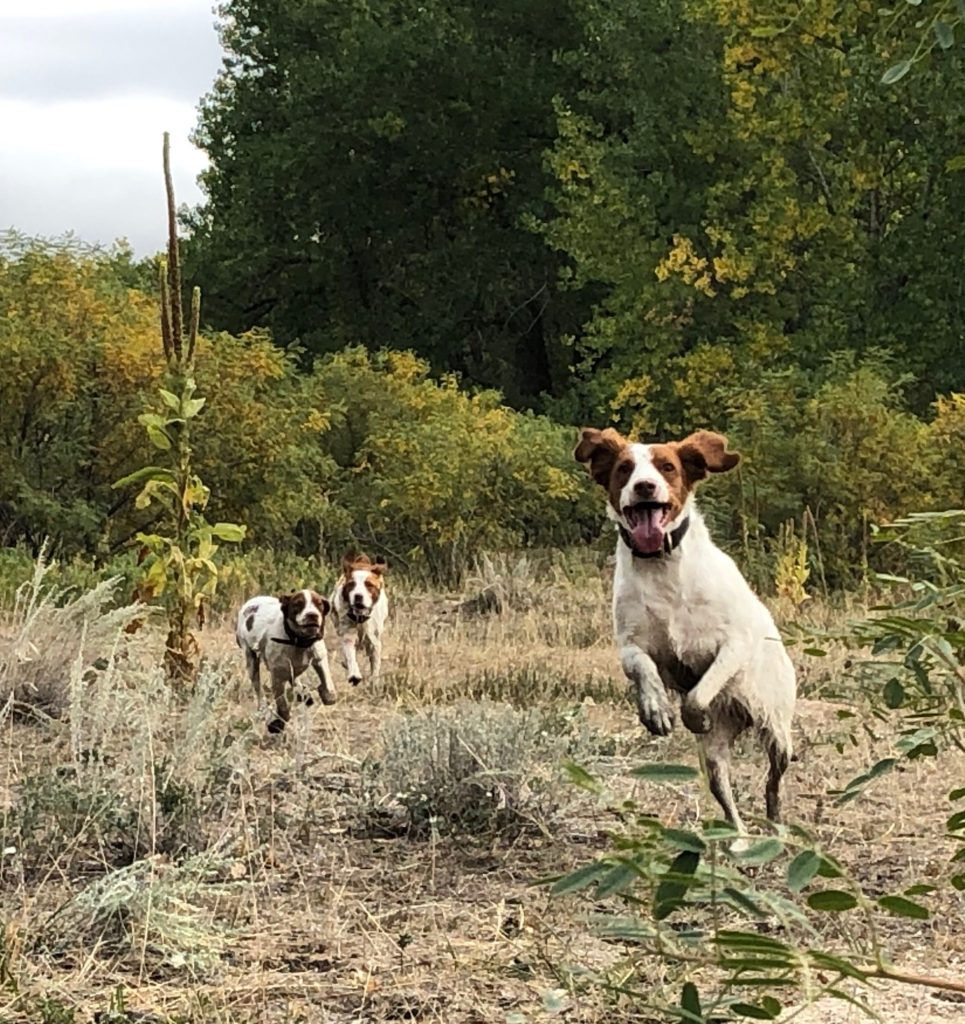
Making a Connection
Gary strives for owners to “commit to making a connection with your dog. It’s all about socialization and development. Make a wholehearted commitment to the pup. Start imprinting with the whistle. Entice them with birds and conditioning to the whistle. Food, love, birds they all equal the whistle.” He recommends developing the pup at a young age. “For young dogs it should be all about birds, birds and more birds. Birds are the magic.” Expose pup to everything, “so you develop that well rounded dog.” Quail are great for pups, “too many pigeons develop bad habits in pointers.”
Gary likes to play “Hide and Seek” with puppies who run off. It’s amazing “if you just silent hide” how they learn to circle back and find you, and then not run off again, much like a kid in a grocery store who gets lost, compared to one whose parent is always nagging them every 30 seconds to come over here, or else.
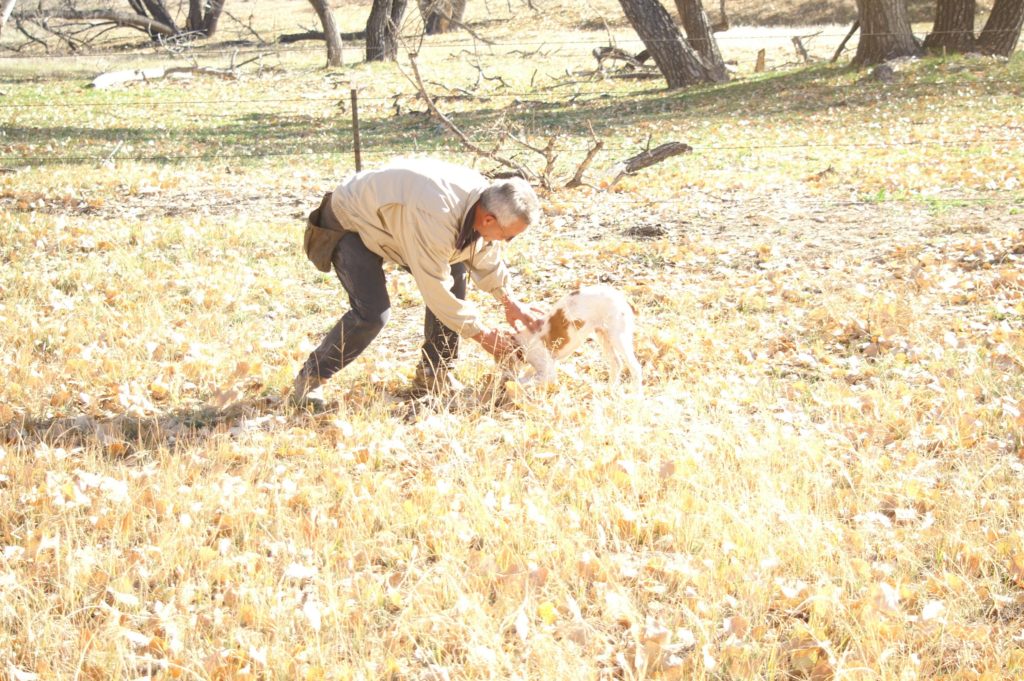
Getting down on pup’s level 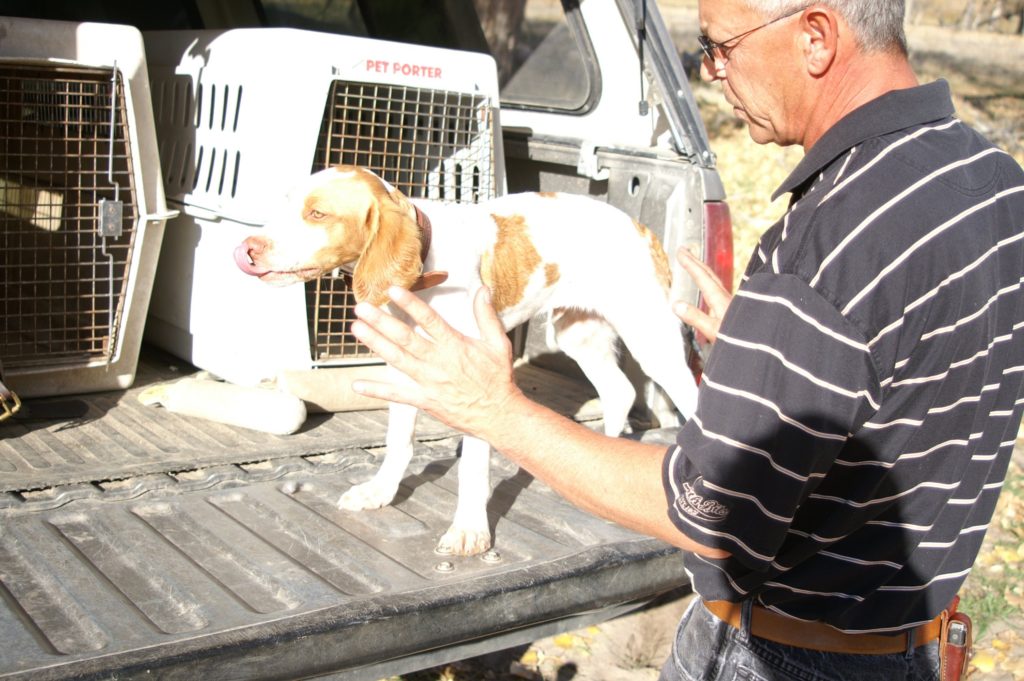
Teaching a patient whoa on the tailgate before letting pup loose to run 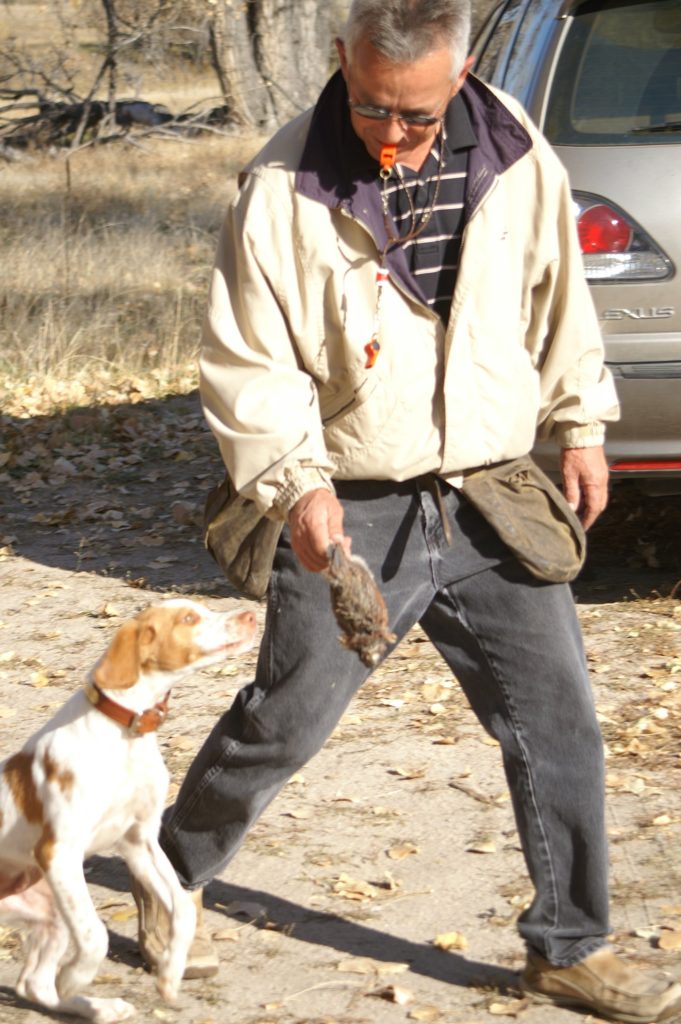
Throwing retrieves for pup 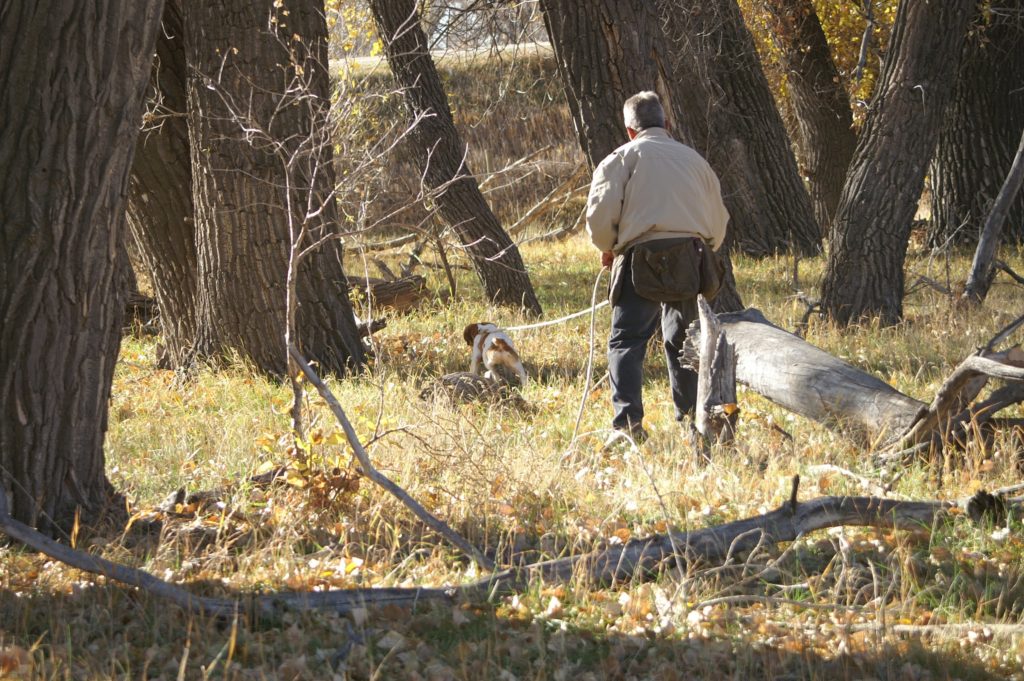
Using the check cord to start enforcing whoa 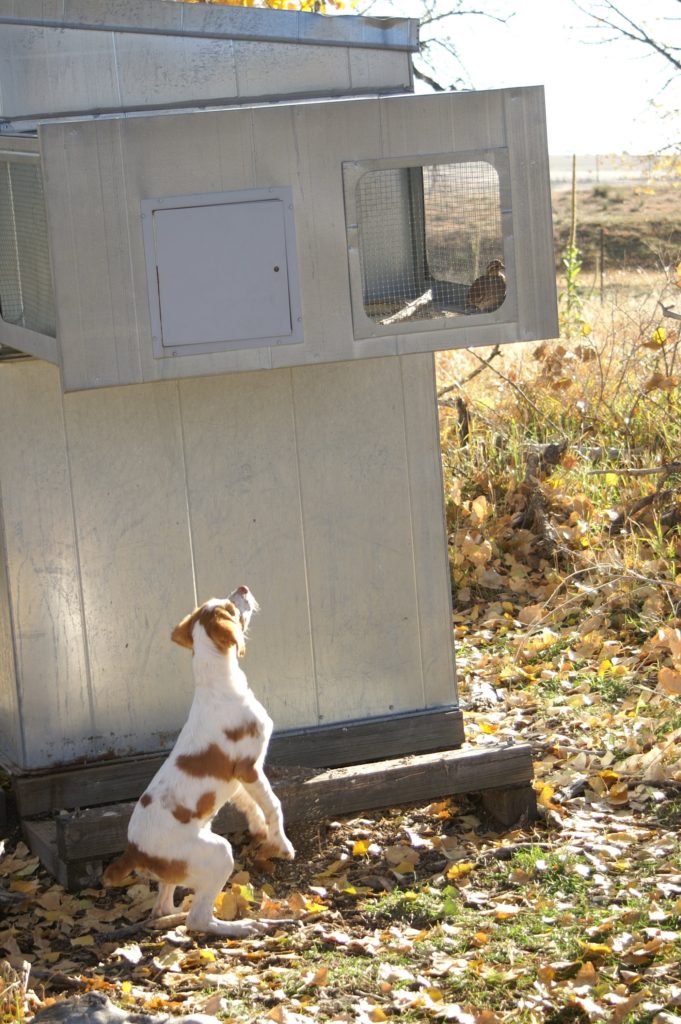
Pup has figured out where the birds come from 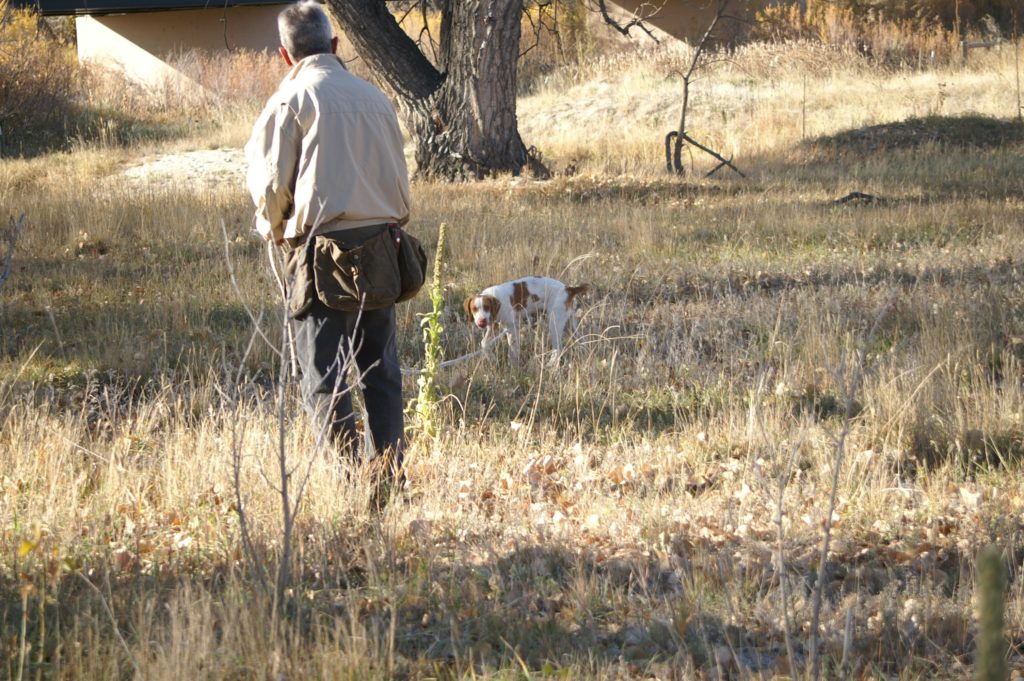
Walk around pup to flush. Not past pup. 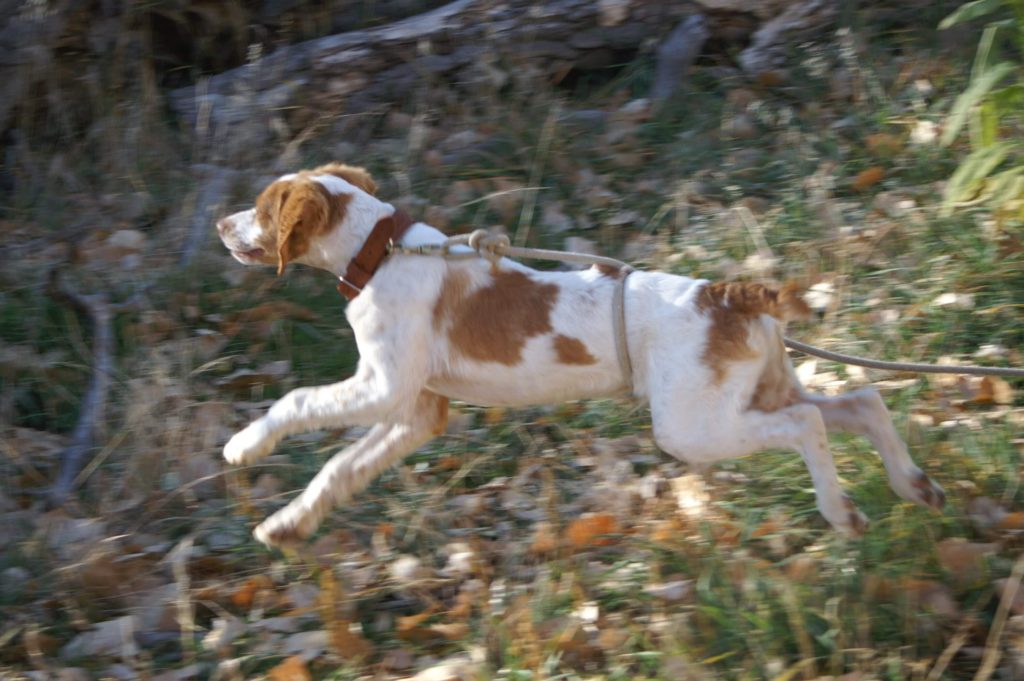
The half hitch doesn’t slow pup, until you need it 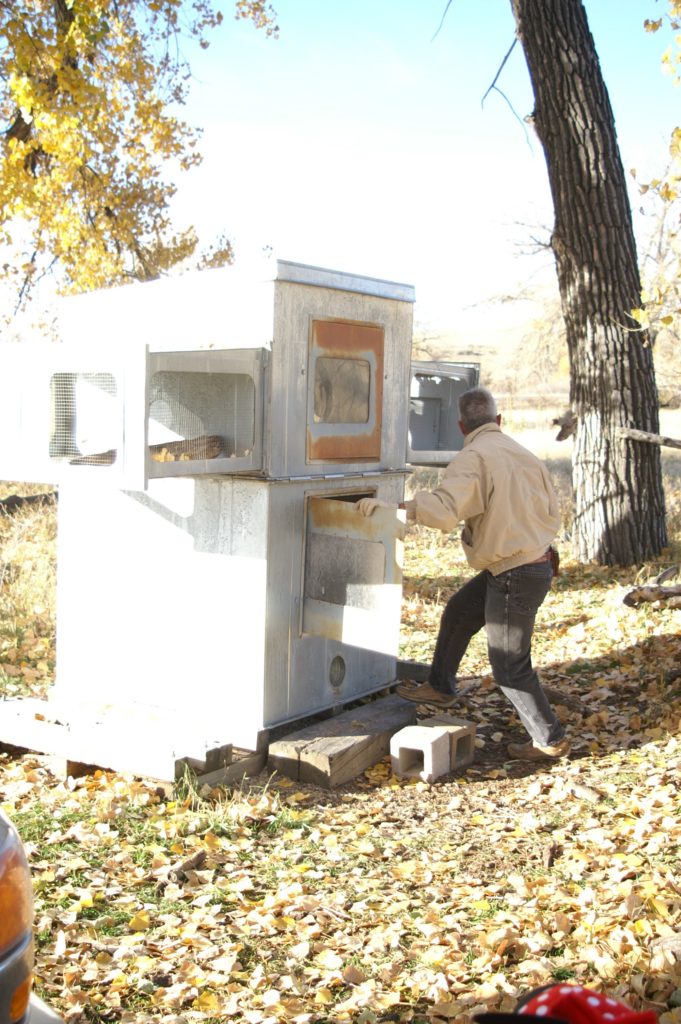
Gary’s quail recall house
At a Year Old Pup Should Have Natural Drive
After a year or so of being a puppy, maybe more or less, depending on the pup, he should have a very strong drive on birds and it’s time to start working on whoa training on live birds. When we transition from the yard to the field, after pup is sufficiently bold and finding and chasing birds, try to get to the end of your dog’s checkcord whenever he goes on point and have a helper flush the bird. You can let him tumble at the end of the check cord without saying anything, then simply pick pup up and move him back to exact spot he broke if he moves, repeating the WHOA command at the instant you set him back down. Again, keep it short and fun, as you reward him with “good boy” and a tap on the head or OK to release. You can also practice WHOA randomly in the field and it helps to start on a road when pup is already on the way back towards you, as this serves as a natural barrier from running off. You can also start working on pigeons with their heads tucked under a wing or pheasants, which Gary prefers to remote release traps, which he used to use, but the noise and closeness of a point on the trap can cause a lot of other problems if not done exactly right each and every time. Kicking around the bushes to find and flush them will also increase staunchness down the road for hunting wild birds, where the same often occurs. At this point, only shoot birds that the dog has done everything right on, is steady and staunch.
You can then progress to bringing pup into sight of backing another staunch dog on point with the assistance of a check cord and helper. Repeat the WHOA command as pup sees the other dog pointing. You can then also decide if teaching sit and down are necessary for your dog. Hunting wild birds should demonstrate the same control on your part to only give commands when necessary and when you’re in a position to enforce. Yelling only indicates a lack of control on your part and/or the dog’s, in which case you need to go back to the basics above. Other hunting companions should be chosen with care. Try to return in full measure all of the love that the dog gives you. Only shoot birds that pup has pointed and held to the flush and only one gun at a time while pup is young to gain confidence without a lot of potentially scary blasting away.
HEEL and WHOA
It helps to have spends a few days working on “heel” and “whoa.” Start off by taking a step with your left foot and have the check cord around pups waist with a half hitch. Then keep the dog so that his head is even with your knee and it helps to get them to use some boundaries in going straight, like a curb or a two track road going straight, before you start doing turns or dropping the check cord momentarily. You can also use a whoa post to wrap the cord around and halting pup when he hits the end of the line, with the whoa command. Then after a while, start incorporating here into all of this, together with toning the dog on the collar to come around, with a “heyyyy-ohhh” and work on this for sometime several days in a row for like a week and you should have yourself a dog who is starting to respect the commands well and starts hunting more in range. You can then expand the range later, for every time we train one thing, we un-train another.
There are some tried and true books, together with some interesting old and obscure books are in Gary’s library… take them all in, as he did. I have read them all and there’s some interesting obscure titles in there. In addition trailing foot scent by the dog and the hassle of lugging them around proved them to be unnecessary.
Whoa Posts and Whoa Tables
Gary has switched over the years from using a whoa table with a cord running back and forth down it to tether the dog’s collar to, to a simple wooden picnic table. More about that later…
A NOTE ON CHECK CORDS
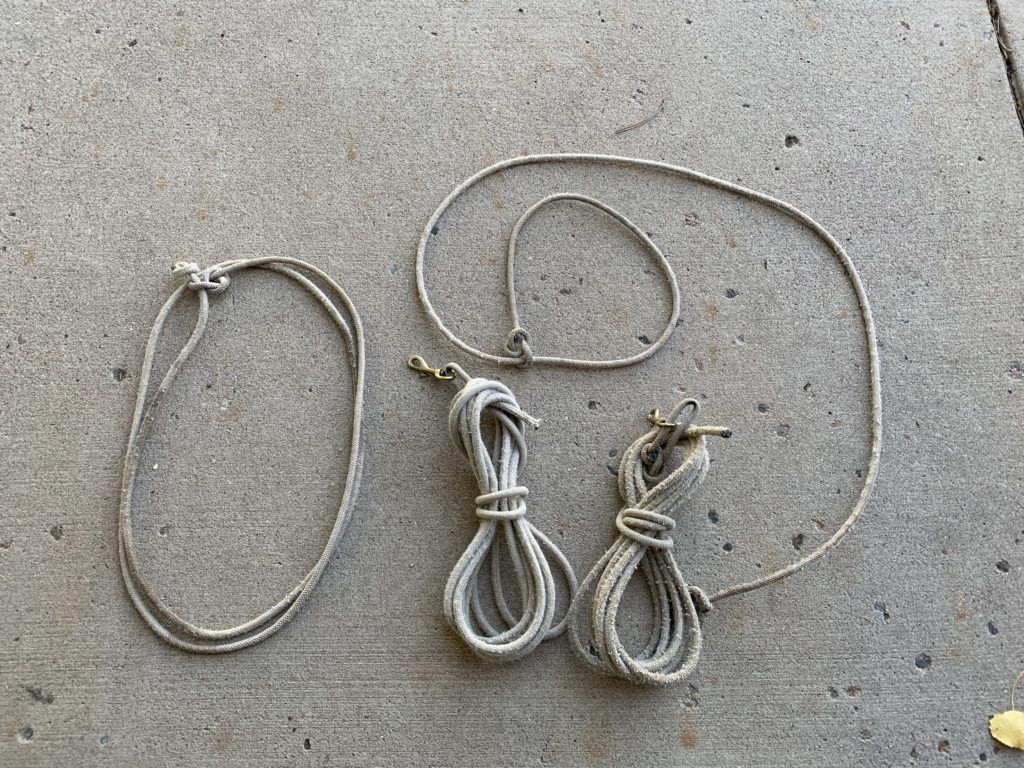
Check cords are deceptively simple. It’s just a rope right? Nope, it has to be the right consistency, or it will get tangled up when you dog drags it at high speed hunting. Having tried dozens of different brands of rope and check cords, there are very very few that work properly.
Check cords should be made of 3/8″ nylon and 20′ in length with a bowline knot and a brass snap. They used to be available from only one gun dog supplier in the south who went out of business 20 years ago, and now the closest you will find to the correct stiffness is the check cord from Cabella’s, which was also recently discontinued. Lcsuppy.com is probably the closest thing out there right now. Gary makes his own now, so you can also buy one from him, which are even better than what’s available commercially.
Half Hitch on Dogs
Gary Ruppel also uses his famous half-hitch with the check cord, which is a trick used to acquaint foals with saddling (his brother was a horse trainer), and it works great on bird dogs to change the point of contact from the collar to the flank. Gary uses it frequently in teaching heel, whoa, and other commands. I am always surprised at its effectiveness and the simple fact that few other trainers have learned this technique.
He also has his own version of the wonder lead, made from this same stuff check cord, which is better than the wonder lead, as it can be worn as a sash around a shoulder and your body when not in use. And it doesn’t snag shut on the dog’s neck, like the lariat cord frequently does. Try the half hitch for yourself.
For dogs that creep on birds, Gary says go back to whoa training in the yard. Your WHOA isn’t there properly.
A Note on Boots and Bells
Try these boots and bells for short periods of time on pup around the house for several times over the course of a few weeks, before a hunting trip, or pup will not be used to wearing them. Start with a cat bell or fishing bell, before you try louder ones made for carrying sound in grouse woods, again working your way up is important So as to not overstimulate pup. Also, always be sure to occasionally gently rub pup’s feet, eyes, ears, muzzle, etc., when watching TV on the couch with pup, so that when you have to handle these sensitive areas later, such as putting on boots or removing a cactus, or feeding a pill, pup will be used to your touch in these areas.
JUST SOME OF THE MANY ARTICLES AND BOOKS ABOUT GARY RUPPEL, TOGETHER WITH MY RECOMMENDED READING LIST FOR HUNTING DOG OWNERS
The Basics of Bird Dog Training – By Bill Tarrant – Featuring Mike Gould
Here’s another great article by Bill Tarrant featuring trainer Mike Gould. And here’s Part II of the article.
Correcting The Bird Dog – Chapter 3 of Problem Gun Dogs by Bill Tarrant featuring Mike Gould
One of my favorite books for dog training is Problem Gun Dogs by Bill Tarrant.
Breeding the Hunting Retreiver by Bill Tarrant Featuring Mike Gould
Here is great magazine article by Bill Tarrant featuring Mike Gould entitled, “Breeding the Hunting Retriever.”
The Pointing Retreiver – featuring Gary Ruppel
The New Dog Men II – featuring Gary Ruppel
Gary Ruppel assorted magazine articles in B&W
Golden Retreiver – The Denver Post – Featuring Gary Ruppel
Meyers Trainers Philosophy Applies to Dogs and Humans – featuring Gary Ruppel
Mike Gould’s Power Bar
This is the Mike Gould power bar, as described in this article by Bill Tarrant.

Gun Dog Training

Tarrant Trains Gun Dogs

Best Way to Train Your Gun Dog: The Delmar Smith Method
by Bill Tarrant (Author)
There’s no doubt that Delmar Smith is one of the original top trainers in America. He’s the type of person you’d want to go out on a hunt with and he has the “Old West” attitude, honest humor in a straight forward manner. Yes, it is an older “training manual” but one can learn a ton about dog behavior and psychology in this book, as written by Bill Tarrant. This was before Tarrant has met Gary Ruppel, so it’s interesting to read to see how he converts from this older school method to Ruppel and Gould’s method in later years. In fairness, Rick and Ronnie Smith, which are Delmar’s sons have evolve their methods over the years as well, so I am anxious to read their new book as well, Training Bird Dogs with Ronnie Smith Kennels. It’s not that one method is wrong and another is right, it’s just that some methods work better from some dogs and some owners better than others do, just like with everything in life. Find the one that suits you and your pup best.
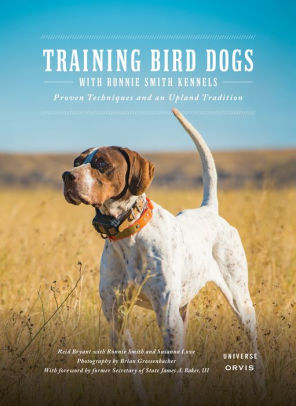

Training the Versatile Retreiver to Hunt Upland Birds
By Bill Tarrant
Bill Tarrant has authored the first book designed to show the retriever enthusiast how to train his dog to hunt upland birds. Bill got together with the four top retriever trainers in America today: Mike Gould, shooting Labs; Gary Ruppel, pointing Labs; Butch Goodwin, Chesapeakes; and Jim Charlton, Golden Retrievers. Together they spent a week training and hunting the various breeds on upland birds. Each night they sat for hours talking a comparing training techniques. The result is this unique book. These five esteemed trainers give you the tools and techniques you need to train your dog to be a more effective hunting companion. you will be training the natural way, without a shock collar. There are also specific chapters on how to train and hunt your dog on pheasants, quail, chuckars, ruffed grouse, sharptails, huns, and prairie chickens. 224 pages.

Plateaus of Destiny by Mike Gould
In this wonderful collection of short stories, Mike Gould takes us from the high montane of Colorado to the canyons of Idaho. It is a book by a master storyteller, someone who still practices the fading art of spinning a yarn by the campfire. Mike writes about a good mountain horse, lightning storms, dogs on point, coveys of blue grouse, an old favorite rifle, and gives a tongue-in-cheek account of how to poach a buck. He also tells us of wondrous things, spiritual things, times of deep despair and the grand majesty of nature. This is a wonderful book that will inspire you and lift your soul.

He Loved the Dog: The Bill Tarrant Story
Mike Gould (Author)
Nonfiction. Bill Tarrant, who passed away in November, 1998, was the dog’s best friend. Bill Tarrant’s personal mission was to promote a new paradigm for treating and training dogs: humanely and thoughtfully. Through his powerful gift of writing, Mr. Tarrant educated people that brutality had no place in dog training. In this new book, Mike Gould honors his friend and continues his legacy.
All of the Rest of Bill Tarrant’s Books Are Highly Recommended
Bill Tarrant was the author of ten books on dogs and was a columnist for Field & Stream magazine from 1973 until his death in 1998. He was named Writer of the Year by the Outdoor Writers Association of America, the Purina Corporation, and the Dog Writers Association of America, the latter honoring him with the award twice. He also received the Orvis Award for Distinguished Outdoor Literature. Gary Ruppel and Mike Gould are featured as some of “Today’s Top Trainers” in the book. Mr. Tarrant was the author of twelve dog and training books, and was the shooting dog editor for “Field & Stream” magazine for twenty-three years. He was the winner of 27 national writing awards. For his book “The Magic of Dogs,” he received a Pulitzer Prize nomination. Other noteworthy books include:

Hey Pup, Fetch It Up

Problem Gun Dogs: How to Identify and Correct Their Faults

The Field & Stream Upland Bird Hunting Handbook

Retriever Pups: The Formative First Year

“Training the Hunting Retriever–The New Program”

Training the Versatile Retriever to Hunt Upland Birds

Pick of the Litter

Bill Tarrant’s Gun Dog Book: A Treasury of Happy Tails

The Magic of Dogs

The Labrador Shooting Dog: Training the Labrador Retriever as an All-Around Sporting Dog Paperback
by Mike Gould (Author)

Instinctive Shooting: The Making of a Master Gunner
Here, point and shoot.” These words from his father propelled Buz Fawcett’s shooting success as a child, gaining him a number of High Gun awards at local trap clubs by the time he was fourteen. Because of his success, his father awarded him his grandfather’s Model 1912 Winchester, which he mastered, even though it “kicked the whey” out of him.
However, his amazing shooting abilities as a kid didn’t follow him into adulthood. Fawcett entered into what he calls his “Dark Ages” of shooting after accepting an associate editor position at Sports Afield in New York City, where he had to read and edit what other gunmen were writing about shooting techniques. Eventually, he took a position as editor of Guns & Ammo magazine, located in California. He soon found himself in a position where he could shoot as much as he liked.
After a number of years and
extensive research into shooting methods, Fawcett rediscovered his talents
through a technique called “Instinctive Shooting.” This research and a lot of
practice finally led to teaching a workshop on instinctive shooting to help others
become adept at this miraculous “point and shoot” method. Instinctive Shooting is
Fawcett’s guide for other gunmen, describing exactly how and what needs to be
done to achieve the ultimate shooting instincts. Practical and hands-on, the
book covers such topics as determining your dominant eye, achieving proper
shotgun fit, how to correct point and shoot, selecting equipment, practice
regimens, mounting, and much more.
150 color Illustrations
Other Favorite Books about Dogs and the Upland Wingshooter
Being a voracious reader, I am often asked about my favorite books for upland bird hunters. All books by Jim Fergus, such as A Hunter’s Road and A Sporting Road, are among my chief favorites. And, I enjoy reading Mike Gould again and again, especially Plateaus of Destiny. But, I have to confess they all feature Brittanys, so that may be part of the allure for me.
![By Mike Gould - The Labrador Shooting Dog: Training the Labrador Retriever as an (2nd Edition) (1999-02-16) [Paperback]](https://m.media-amazon.com/images/I/51dH7a7mB0L._AC_UY218_SEARCH213888_ML3_.jpg)
Gould’s Labrador Shooting Dog (it features pointing labs, but this training method works for all pointing dogs and is the method I follow, having studied under Gary Ruppel. And Bob Wehle’s Wing and Shot features the more traditional methods and is well written. If you had to stop with just these few, you really wouldn’t need any more to become fully educated on pointing dog training, especially for Gary Ruppel’s natural method of dog training, which is not focused on the electric collar and force breaking methods. The others mentioned above will show you what you can accomplish with this training method.
But if you will not be satisfied knowing that there are so many more books out there to read, one could move on to all of the books written by the late, great Bill Tarrant would be next to add. Bill was a gentle soul, a voracious writer and focused heavily on learning from and writing about professional trainers. He praised most, both in his writings and in his conversations with me, Mike Gould and (his protégé at the time) Gary Ruppel, for the “new school” of professionals. Some of Bill’s books are more how-to, others are more interviews, and some are fictional. The titles tell you which way they go, there are about 8-10 of them all together.



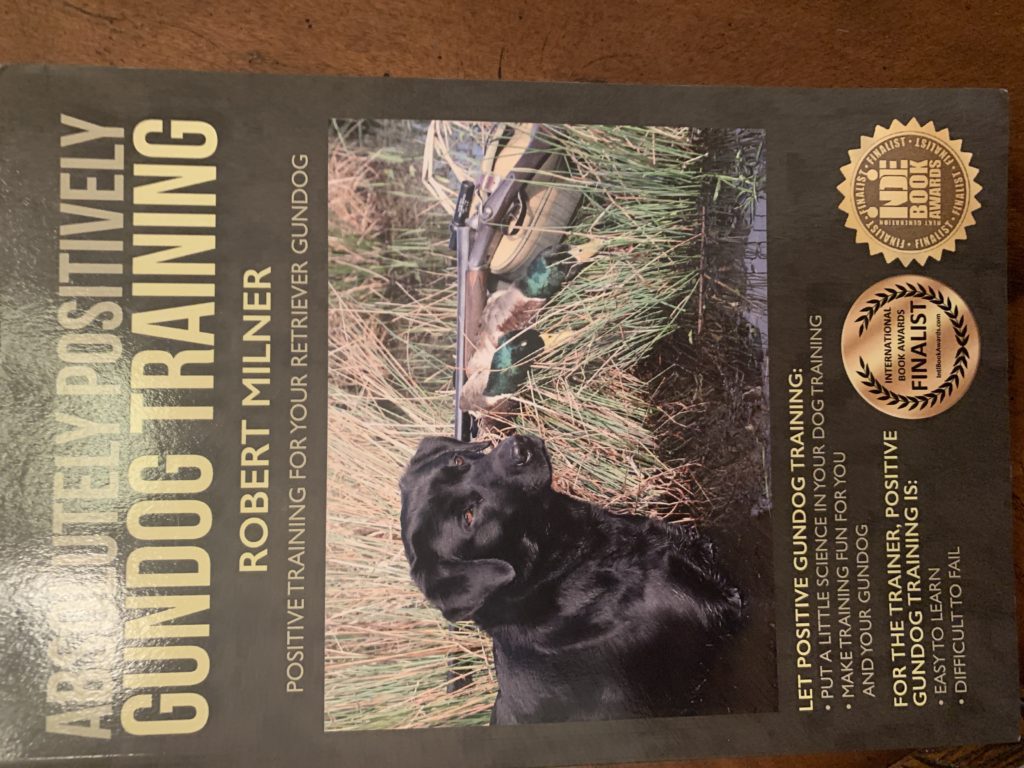

These books by my acquaintenance and retired school teacher Ben Williams, who lives in Montana with his pack of hard charging Brittanys for some 40 years now, are somewhat directed at the Brittany lovers. His writing is elegant and easy to read and his method features a very natural method but a bit more directed to what I’ll call pack hunting in big sky country. If that doesn’t give it away just by the mention of Brittanys in Montana, I am referencing Bird Dog: The Instinctive Training Method by Ben O. Williams. His Western Wings, American Wingshooting, Winston, and all of his books about individual species are also worth reading.

And then three are the classics for pointing dogs (which will show you the old school methods): The Gun Dog Book and Gun Dog Training: Pointing Dogs.

And, finally, the ones you will need for hard charging Brittanys like mine, who always seem to find a way to bust through barbed wire or find other troubles: Advanced Canine First Aid DVD and A Field Guild to Dog First Aid.

My bird hunting veterinarian buddy always recommends Wehle’s Wing & Shot, which is of course mandatory reading for serious gun dog owners.

As is Bob Whele’s Snakefoot book. He was a very interesting and extremely knowledgeable trainer, that I was happy to have
He also recommends Steven J. Mulak’s Pointing Dog’s Made Easy & A Brief Autumn’s Passage, Joel Vance’s Bobs, Brush & Brittanys and you can’t forget The Rufus Chronicles too! I love those books too, but am now more inclined to Gary and Mike’s methods exclusively. Anything by George Bird Evans and Mark J. Volk are also among our shared favorites.
